Cynodon dactylon



Stemless / Acaulescent
A plant that has no stems, when the flower stalks and leaf blades are produced from ground level.
Prostrate mat-forming
When a plant forms a dense close cover over the ground or a structure, ie. Turf grass.This is a warm season perennial grass spreads both by stolons and rhizomes and forms a prostrate habit. It has fine texture dark green lanced-shaped leaves that turn brown when dormant. If closely mown it forms a compact dense lawn.
Cynodon dactylon (L.) Pers. natural habitat is uncertain but is thought to originate from Africa to India growing in grasslands, riparian zones along water courses and around wetlands. It has also naturalised in many countries including Europe, Pacific islands, Asia, China, southern North America, South America, Australia and Bermuda where it is regarded as a weed. It appears from sea level to an elevation of 2,200 m (7,217 ft). It has a medium texture that becomes finer under cultivation with greater density and is prostrate, forming from rhizomes and stolons with very fibrous roots that form a tight sod. It prefers a well drained fertile to poor moist sandy to loamy soil that is acidic to alkaline with a pH range from 4.5 to 7.5. It grows in a open sunny position and is frost, saline soil, drought and heat tolerant with a preferred minimum winter temperature of 2ºC (36ºF).
Common Couch (Bermuda grass) is a hardy long lived grass that is grown for its fine texture. It is cultivated as a domestic lawn or used on summer sports fields, golf courses, bowls/croquet, racetracks, lawn cemeteries, parks and reserves. It is an excellent lawn with leaf blades that are soft, smooth to partially hairy. It tolerates close mowing and forms a dense cover but has become a weed in bushland areas. It generally has a medium water requirement once established (Scale: 2-drops from 3) during the growing period but can survive prolong dry periods.
I.D. 410
UK hardiness zone H3
Climate zones 5 - 10, 12 - 24, H1, H2
USDA Zone 9-12
Cynodon (SIGH-no-don) dactylon (DAK-ty-lon)
Etymology
Genus:-Greek - Cynodon – ‘kuon’ (dog) and ‘odous’ (tooth) referring to the sharp scales on the rhizome
Species: Greek – dactylon – ‘ daktylos’ (finger) referring to the finger-like flower spike
Couch Grass
This long-lived grass is found in warm humid to semi-arid regions making it the most widespread flowering plant in the world. It is found both inland and in coastal areas and discolours in the cool autumn period remaining dormant throughout winter.
Note:
Detailed information on the species is found under the Cultural Use heading.
Hybrids
Derived from Cynodon dactylon x Cynodon transvaalensis
Common name: Hybrid bermudagrass
General description: These turfgrasses have a fine texture and high density and are generally dark green. They form a prostrate growth habit from rhizomes and stolons that root freely at the nodes producing deep roots. The seed heads do not produce viable seeds. They are widely used as turf grasses in warm climates and do not mix well with other grasses.
Plant Use: They are commonly used in golf tees, surrounding fairways and greens and in cricket wickets. These grasses are also used in fine lawns or summer sport fields and quality sport fields.
Positives: These grasses can tolerate close mowing forming fine turf. They are heat and drought tolerant and establish quickly from stolons. During the growing period they repair from damage quickly and have good green up in spring.
Negatives: These grasses tend to form excessive thatch and require regular de-thatching. They can only be propagated vegetatively and some hybrids lack vigour during winter. They also are susceptible to some Patch disease.
Cultivars
'Tifway'
This first generation sterile hybrid has dark green stiff leaves and stems that generally show a reddish colour. It is an aggressive grower and is weed and disease resistant.
'Tiffine'
This F1 hybrid is the result of a cross between female parent C. dactylon and male parent C. transvaalensis that took place at Tifton in 1951. The foliage is light green and it is not often used today.
'Tifgreen'
This F1 hybrid is the result of a cross between female parent C. dactylon and male parent C. transvaalensis that took place at Tifton in 1951 and released in 1953. The foliage is medium green and has a finer, soft texture.
'Tifdwarf'
This natural mutation of 'Tiffgreen' is sterile and is extremely dwarf variety that has dark green fine textured leaves. It tolerates low temperature; some shade and close mowing. It was first noticed in 1956 and released in 1965.
'Royal Cape'
This selected variety was made in South Africa in 1930 and released in California in 1960. It has superior texture with dark green leaves and withstands wear with some tolerance to saline soils.
'Riley's Supersport'
This hard wearing hybrid is used on sport fields and recovers quickly from heavy traffic.
'Santa Ana'
This is a hybrid cross between common couch variety 'Royal Cape' and South African Couch. It grows to 150 mm (6 in) becoming heavily thatched and maintains some green colour in mild winters. Used in moderate traffic areas and is smog tolerant.
'Greenlees Park'
This is a natural dwarf selection, which is blue-green in colour and tolerates close mowing, high intensity culture but may be susceptibility to some diseases. It is used in bowling clubs.
'Wintergreen'
This selection of common couch is semi-dwarf with light to mid green leaves that maintain colour under heavy frosts and throughout winter. It is used in domestic gardens, sports fields and for general landscape use.
'CT2 Couch'
The male parent is 'Wintergreen' and female is 'Greenlees Park' making CT2 an F1 hybrid. It has less thatch build-up with better colour throughout winter, quicker recovery during spring with rapid establishment time and no fungal or disease problems. It is used on playing fields, fairways and in domestic gardens. This lawn prefers a well-drained soil and suffers in wet soils.
As a weed Couch is extremely tenacious tolerating dry conditions, heavy traffic and exposed positions. It is commonly found in disturbed soils forming a cover that inhibits the regrowth of smaller indigenous flora. It is commonly dispersed in garden waste or escapes from planted lawns along bushland edges. Control methods include physically digging out small patches or covering the area with plastic sheeting for 4 - 12 weeks until the grass is dead. The plant may also be sprayed with a non-selective herbicide that will require a follow up as it can take up to 2 years to eliminate an infestation.

Africa to India
Poaceae (poh_AY-see-ee)
Grass Family
This large family is the most economically important and includes annual herbs, stoloniferous and rhizomatous perennials normally with fibrous roots and sometimes woody shrubs. The grasses are normally perennial and have rhizomes or form a tufted habit.
Distribution
These plants appear in most areas of the world from Antarctica to the tropics and account for 25% of the world's vegetation but are not common in rainforests or in dry heath. They appear from high altitudes to sea level and are commonly interspersed between trees and shrubs.
Diagnostic Features
These plants have fibrous roots that may be developed adventitiously from the lower stem nodes. The hollow stems are called culms and are cylindrical and are sometimes solid. A few species form bulbs or corms.
The leaves consist of two parts, the sheath and the blade and have a membranous or ciliate rim with the ligule found at the internal junction of the two. The sheath encircles the stem and has overlapping margins or are sometimes fused forming a tube around the stem. The blade can be narrow or broad and are usually lanceolate, linear to ovate and can be evergreen or occasionally deciduous. The base may also have a meristematic region at the base allowing the leaf to continue to grow after cutting or grazing. The size is variable from bladless to 5 m (16 ft) long.
The inflorescence is normally found at the stem apex inside the upper most leaf sheath and may be a simple or compound panicle, raceme or spike and vary in size up to 2 m (6 ft) long. They are sometimes a combination and commonly known as a spikelet.
These spikelets are consisting of 2 opposite rows of bracts that are arranged along an axis (rachilla). Glumes are the 2 lowest bracts and are empty with the remaining (lemmas) form a part of the floret with the reproductive parts enclosed between the lemma outside and the inner highline scale (palea).
The numerous small florets (spikelets) are composed of the lemma, palea, stamens and sometimes an ovary, stigma with 2 - 3 membranous scales (lodicules) which are found at the base of the reproductive parts.
The spikelets are normally bisexual or barren and may have a hard basal point (callus). In some cases both female and male spikelets are born on the same plant. The glumes, lemmas and pleas may have bristles (awn).
There are 3 stamens and a feathery stigma on top of a superior ovary that contains one chamber and one ovule.
The fruit is a one seeded caryopsis that has a thin pericarp or is a utricle (achene) with the seed being free. Some bamboo species produce a berry-like fruit and some other species produce a nut. Commonly a part of the inflorescence is incorporated in the seed to help with dispersal such as in tumbleweed or hooks and barbs.
Note:
There are 12 subfamilies and grasses are a principal source of food and changed the course of humans from foraging 23,000 years ago to farming around 10,000 years ago. Many of the grasses are used for domestic lawns, playing fields and as ground covers and many are regarded as weeds.
Features of Turfgrass (General)
Density
This refers to the number of leaf blades per square centimetre, high has many leaves.
Texture
This refers to the width of a leaf blade with fine texture having a narrow leaf as in Bent or Fescue. Course textured is as Buffalo. Regular close mowing forms a finer texture with most grasses.
Uniformity
This is the even appearance of a turf and depends on the mass aerial shoots with the evenness of the turf surface.
Note:
when different turfs are grown together they contribute to a non-uniform appearance.
Smoothness
This reflects the quality of the cut surface to evenness or smoothness.
Resilience
This refers to the turfs capability to endure shock without damaging the surface characteristics and allow a cushioning effect for a falling footballer thus reducing injury.
Rigidity
This refers to the resistance to wear of the turf through the compression of the leaf blades.
Colour
This is normally an indication of health of a grass during the growing period; dead areas indicate something is wrong, as in dryness, disease or insect attack.
Mat and Thatch
Turf grasses vary in there ability to produce mat and thatch. In certain sports some thatch is an advantage as in football but where a hard and fast surface is required as in cricket and bowling it should be kept to a minium.
Rhizomes and Stolons
Rhizomes are a stem that grows horizontally below the soil and eventually comes to the surface where it can form an identically plant to the parent plant.
Stolons are stems that grow horizontally above the ground, rooting at nodes and producing an identical plant to the parent plant.
This plant tolerates between USDA zones 9a to 12a and grows to 40cm (16in)
Fahrenheit 20º to 55º F
These temperatures represent the lowest average.
Celsius -6.6º to 12.7º C

Attention
This plant was last revised on the 10/01/2024
All photographs and data are covered by copyright. Apart from any fair dealing for the purpose of private study, research, reference or review, as permitted under the Copyright Act, no part including images and text may be reproduced by any means without written permission. The information presented in the map is only indicative and may contain errors and omissions. All inquiries should be addressed to sales@plantfile.com attention Peter Kirkland.

Simple
The leaf that is not divided.
Lanceolate
Broadest at the centre, three or more times long as broad (Lance-shape).
Alternate
Leaves are arranged alternately along the stem.
Serrulate
A leaf margin with diminutive conditions of serrate(small serrations).The lanceolate leaves are flat and stiff from 20 mm (¾ in) to 120 mm (4 ¾ in ) long by 5mm (¼ in) wide with a few scattered hairs and the underside is glabrous. The margins are scabrous.
Ligule: Fringe of white hairs
Collar: Continuous, narrow, smooth, hairy on margins
Sheath: Compressed to round, split smooth to sparsely hairy.
Auricles: Absent
Vernation: Folded


Panicle
Branched with large loose clusters.| Jan | Feb | Mar | Apr | May | Jun |
| Jul | Aug | Sep | Oct | Nov | Dec |
The purplish black inflorescence is a 4 to 5 digitate panicle with 5 branches up to 10 mm (3/8 in) long (windmill-like) held erect above the foliage on a slender scape and have spikelets that are 2 - 3 mm long. The lemma is boat-shape with a fringe of hairs and is longer than the glume. They appear during summer.

Caryopsis
This is an Achene with the pericarp attached to the seed (cereal grain)."Common Couch (Bermuda grass) is a hardy long lived grass that is grown for its fine texture. It is cultivated as a domestic lawn or used on summer sports fields, golf courses, bowls/croquet, racetracks, lawn cemeteries, parks and reserves. It is an excellent lawn with leaf blades that are soft, smooth to partially hairy. It tolerates close mowing and forms a dense cover but has become a weed in bushland areas. It generally has a medium water requirement once established during the growing period but can survive prolong dry periods.
General description: This turfgrasses has a medium texture that becomes finer under greater density and generally dark green. It forms a prostrate growth habit from rhizomes and stolons that root freely at the nodes producing deep fibrous roots and tight sods. The seed heads produce viable seeds.
Plant Use: It is commonly used in golf tees, surrounding fairways. These grasses are also used in summer sport fields and parks and reserves.
Positives: This grass is very vigorous and is ideal for areas that are frequently damaged or divoted. It is heat, drought, wear and moderately salt tolerant. During the growing period it repairs from damage quickly.
Negatives: This grass tends to form excessive thatch and require regular de-thatching and invades adjoining turf grass areas. It has poor cold weather tolerance and looses colour when frosted and dislikes shaded positions.
Tolerance
High Temperature
Poor Average Excellent
Drought
Poor Average Excellent
Close mowing
Poor Average Excellent
Low fretility
Poor Average Excellent
Frost
Poor Average Excellent
Shade
Poor Average Excellent
Wet soil
Poor Average Excellent
Wear
Poor Average Excellent
Salinity
Poor Average Excellent
New growth rate Oversowing rate Stolonising rate Mowing heights
g/m² lbs/1000sq ft g/m² lbs/1000sq ft Kg/100 m² lbs/1000sq ft mm inches
High 15 3.1 0 0 20 41 40 1.6
Low 10 2.1 0 0 5 10 4 0.2
Note:
This plant is susceptible to the Mole Crickets, Brown Patch, Curvularia Leaf Spot, Downy Mildew, Helminthosporium Disease, Rolf's Disease, Spring Dead Spot, Parasitic Nematodes, Felted Grass Coccid, CouchTip Maggot, Flea Beetle, Dry Patch, Fusarium Patch and Anthracnose.
Turfgrass culture (General)
The Seedling Stage
At this stage the turf has a shallow root system and requires adequate moisture at all times.
Watering is a case of balancing the evapotranspiration rate of the plant, ie watering before it wilts but don't over water or the plant as it will drown through the lack of air (co2) in the soil.
Wilting may also occur in high temperatures when demand for moisture is greater than absorption rate of the plant.
Improper irrigation techniques or overwatering can result with turf that has a short root system or death of the plant.
Compaction
Compaction may result from overwatering creating less air (co2) and drainage in the soil and coupled with excessive traffic such as pedestrians, machinery and players results in certain death of the grass.
This is poor management and a balance must exist to ensure good growth of the turf.
Turfgrass prefers well drained light loams that are less prone to compaction. In heavier soils the grass is under greater stress and requires careful management methods to ensure good drainage and aeration of the soil.
Temperature and Growth
Most turfgrass growth occurs between 5º to 30º C. Absorption of thermal radiation is governed by the colour of the grass, ie-lighter green grass reflects and darker green absorbs.
Turfgrass has two types of dormancy, low temperatures and high temperatures.
At low temperatures the turfgrass vary in there tolerance having a winter period with little biological activity occurring or it may become completely dormant and loose its entire colour.
During this period of dormancy the turfgrass may be damaged from plant desiccation, cold stress and low temperature fungi. Walking on frozen grass causes damage from crushing.
During high temperatures normally above 32º C turfgrass has little biological activity (stops growing) and becomes dormant. If the period of high temperatures or drought persists the leaves may wither and die off completely but normally returning during more favourable conditions.
Heavy or light shade influences ground temperature and may substantially effect the growth of the turfgrass.
Summer dormancy may be controlled with the use of irrigation; this also allows some cool season turfgrass to grow.
Light and Growth
Regularly mowed turfgrass may only absorb 1 - 2% of the total incidents of light because most of the leaf blade has been removed. Light quality has a direct effect on growth.
When shaded the plant cannot manufacture food and looses vigour. It is then more prone to damage through wear or hot and cold temperatures, it's a weaker plant.
Cultural practices such as mowing at a higher level, controlling traffic and less fertiliser will assist the turfgrass to grow in the shade.
Note:
Heavily shaded areas may require a different type of ground cover plant.
Root to Shoot Growth Ratio
The leaf and root systems interrelate in that the larger the leaf is the deeper and stronger the root system is. Uncut grass has an extensive root system.
Regularly mown turfgrass roots will retract in direct relationship to the hight of the grass resulting in a short root system that is susceptible to stress through moisture loss.
Under these conditions cultural practices such as cutting at a higher level, improving aeration through slicing, spiking or coring will assist in reversing the biological response and developing a deeper root system. Deep watering and adequate nutrition will also help.
Soil pH and Salinity
Turfgrass prefers a soil pH between 6 and 7 because most nutrients are freely available to the plant. If the pH is 5 or 7 the turfgrass stresses due to the lack of access to all nutrients, this soil should be avoided or improved.
Salinity in the soil should be monitored and be in a range of 0 to 45 parts per million to be acceptable. Some species of turfgrass tolerate much higher levels.
Sow fresh seed during spring in situ.
Plant runners (stolons) from spring to summer and keep moist.
Cultivars must be propagated vegetatively to ensure true to type.
Propagation by Seed (General)
Germination
In order for a seed to germinate it must fulfil three conditions.
1. The embryo must be alive (a viable seed).
2. The seed must have no dormancy-inducing physiological, physical or chemical barrier to germination; also the seed must be nondormant.
3. The seed must have the appropriate environmental requirements, water, temperature and oxygen.
The interaction between these requirements and dormancy is complex and may lead to different environmental requirements that avoid the dormancy of a seed.
Sowing Seeds in Containers
There are two general methods for germinating seeds.
1. Sowing seeds in a flat or germinating bed, through which seedlings are pricked-out then, transplanted into another flat with wider spacing or directly to an individual pot.
2. Sowing seeds by placing them in to flats with the appropriate spacing or into individual pots.
This method is normally carried out with medium to large seeds such as woody plants and plants that are difficult to transplant.
Seedling production normally occurs in a greenhouse / glasshouse, cold frames and on hot beds.
Method of Seed Sowing
Fine seed is sown in pots or flats that are no deeper than 70 to 80 mm (3 1/8 in). using a sterilised well-drained media (soil). Fill the container to 20 mm (¾ in) from the top and sprinkle sieved peat to 3 mm (1/10 in) depth.
Press the media down level and firm with a piece of timber and then thoroughly moisten.
Mix the fine seed with washed sand and then sow thinly on the surface. These may be lightly covered with sand.
Larger seeds may be covered with media or a hole is dibbled and the seed is placed in the media.
Watering Methods
For watering you may either mist the containers from above or place the container in tepid water and allow the water to raise through the pot to the surface of the media, then drain away and do not fill to the top of the container.
Place a piece of glass over the pot and store in a protected warm environment (glasshouse).
Seeds germinate best in darkness so shade the containers if in direct sunlight.
After the seedlings have sprouted remove the glass and ease the seedlings into direct light.
When the seedlings are large enough prick them out and transplant into larger containers then place them in a shade house to harden off.
Many seeds have different methods of seed preparation for germination such as nicking or cutting the seed coat to allow water penetration, also placing seeds in hot water and allowing it to cool off.
This is particularly important as it is softening the seed coat.
Asexual Propagation (Cuttings general)
Propagation from cuttings is possible because every cell of a plant containers the genetic information to create an entire plant.
1. Reproduction occurs through the formation of adventitious roots and shoots.
2. The uniting of vegetative parts with budding and grafting.
3. Taking stem cuttings and layering is possible due to the development of adventitious roots
4. Root cuttings can form new shoots then it is possible to join roots and shoots to form a new plant.
5. A new plant may be formed from a single cell in an aseptic culture system, (cloning).
It is important to propagate vegetatively as this form of cloning retains the unique characteristics of the cultivars or where particular aspects of a plant may be lost if propagated by seed.
Equipment Required for Taking Cuttings
1. A sharp knife that is not too large or a razor mounted in a handle.
2. Good pair of sharp secateurs that is clean.
3. A dibbler to make a hole in the media and allow the cutting to be placed in.
4. Propagation structures that are either a timber frame with glass or polyethylene cover or a glasshouse.
The object of the structure is to create an environment where the temperature and humidity can be controlled. This can be achieved with a simple cover over a pot with a wire frame and plastic.
This stops the draughts and maintains humidity.
5. A hotbed is a useful item as many plants root more quickly if the media is slightly warmer.
Bottom heat is obtained from thermostatically controlled heating cables that are running under the media.
6. Misting systems are of great benefit to cuttings as the regulated fogging with water inhibits the cuttings from drying out and as a result the cuttings may be grown in full sun.
This results in faster root development that is less subject to diseases by fungi and bacteria.
7. Rooting mediums
The rooting medium must be well drained, sand may be used as long as it is thoroughly washed and leached of all salts. It is very well drained and it is excellent for cutting that root up quickly. Equal parts of sand and peat moss have good results for cuttings, which are left for a period of time to allow the roots to form.
Vermiculite and perlite are also used as a well-drained rooting media but has the same disadvantage as sand having no nutrients. The cuttings must be potted up as soon as the roots developed, or a light application of liquid fertiliser can be applied.
Types of Cuttings
Stem cuttings
These are the main types of cuttings.
1. Softwood cuttings
These cuttings are taken from young growth on side shoots and tip growth.
2. Semi hardwood cuttings
These cuttings are taken from wood that is firmer and semi ripe usually during mid summer.
3. Hardwood cuttings
These cuttings are taken from mature wood normally towards the end of the season.
4. Root cuttings
Cut sections of roots to obtain new plants during late winter to early spring.
5. Leaf cuttings
Cut the leaf blade in order to obtain new plants during the growing period of the plant.
Cutting preparation
Hardwood cuttings
When taking hardwood cuttings remove the leaves and in semi hardwood reduce the number of leaves by half. Cut the wood straight across just below a node or joint. Hardwood cuttings are normally between 100 to 760 mm long and may have either a heel of the older wood attached to the base, or a short section of the older wood at the base. These cuttings are prepared during the dormant season from late autumn to early spring and are made up from previous season's growth.
This type of cutting is used for woody deciduous plants such as Crepe Myrtle, Rose rootstocks and some fruit trees.
The cuttings should be healthy wood with ample supply of stored food as to nourish developing roots, shoots and placed in the rooting media with the aid of a dibbler stick.
Softwood cuttings
The cuttings for softwood should be 60 to 130 mm (5 1/8 in) long and be of material with enough substance as to not deteriorate before the new roots appear. Cut below a node and retain the leaves on the upper portion. Place in a well-drained media and maintain a high humidity.
Soaking the cuttings and leaving them standing in water for long periods is undesirable.
Herbaceous cuttings
These cuttings are taken from succulent plants such as Geraniums and Coleus. The cutting should be 70 to 130 mm (5 1/8 in) long with leaves retained on the upper end. As in softwood cuttings these require an environment of high humidity. Some fleshy cuttings ooze sap and may require a drying period for a few hours before being placed in the rooting media.
Leaf cutting
In these cuttings a leaf blade and petiole or part off is used to raise a new plant. The original leaf doses not become a part of the new plant as roots and shoots appear from the base of the leaf. In some cases roots appear from the severed veins.
Leaf-Bud cuttings
These cuttings incorporate a leaf, petiole and a small piece of the stem. These cuttings are an advantage where the plant uses the axillary bud at the base of the petiole for new shoot growth and maximises available propagation material, as each node will produce a new plant.
As in softwood cuttings these require an environment with high humidity and warmth.
Root cuttings
These cuttings are best taken from younger plants during late winter to early spring prior the new season's growth unless the dormant period is during summer.
Trim the roots as they are dug up, to maintain polarity cut strength at the crown end and a slanted cut at the distal end (away from the crown).
Root cuttings of small plants are placed in flats in lengths of 20 to 50 mm (2 in) and laying horizontally on the surface of the soil. These may be lightly covered with sieved sand or media, watered and then placing a piece of glass or polyethylene over the container till roots / shoots appear.
Fleshy root cuttings
These cuttings should be 50 to 75 mm (3 in) long and placed vertically in a well-drained sand media.
Keep the polarity correct and when the roots develop transplant the cuttings into a separate container.
Large root cuttings
These cuttings are 50 to 150 mm (6 in) long are tied up in bundles and placed in boxes of damp sand, sawdust or peat for about three weeks at a temperature of 4. 5 deg C When taken out they should be planted in a prepared bed 50 to 80 mm (3 1/8 in) apart with the tops of the cuttings level with or just below the soil level.
PEST
NAME
African Black Beetle
Heteronychus arator
ORDER
Coleoptera
FAMILY
Scarabaeidae
Description of the Pest
The African Black Beetle is a stout scarab, with glossy black wing covers and up to 12mm long. The cream coloured larva or curl grub is up to 25mm long. It has a fleshy body with a hard shiny head capsule. The larva has a characteristic 'C' shape. It has true legs and the end of the abdomen is slightly swollen with a darker internal colour. Its mandibles are large jaws. Both adult and larva have chewing mouth parts.
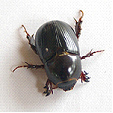 Adult
Adult 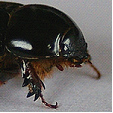 Adult note the front legs
Adult note the front legs
Life Cycle
This insect has a Holometabolous life cycle, i.e. it has a larval and a pupal stage.
The adult lays eggs in the soil over a three month period and both eggs and larva can be found in the soil at the same time. There are several larval stages before pupating in the soil during mid summer and emerging as adults. The adults live for up to a year but overwinter in the soil in a semi dormant state.
Distribution of the Pest
This insect pest is widely distributed throughout Australia and New Zealand. Native to Africa
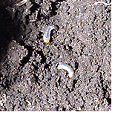 Larva in the soil
Larva in the soil 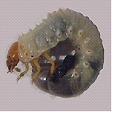 Typical C shaped larva
Typical C shaped larva
Period of Activity
The adult is active during spring followed by the larvae. . The adults are seen flying in late spring and late summer to autumn seeking soft moist soil to for egg laying.
Damage Caused
The adult beetle and lava feed on below ground parts of the plant, but it is the lava that causes most of the damage with there prominent jaws. Small roots are completely eaten and larger root have sections eaten away. This causes seedlings to topple and die or small shrubs loose vigour. Lawns develop dead patches particularly during dryer weather as the lava eats the roots. The late larval stages cause the most damage as it becomes larger and active. The lava is not normally seen but loss of colour in foliage plants or dead patches in lawns may indicate its presence. Plants attacked can be easily removed for the roots have been eaten. This pest is normally associated with bent & couch grass although they can feed on the roots of shrubs and trees. Damage by the feeding adults is normally minor.
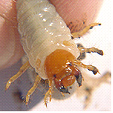 Chewing Mouth parts
Chewing Mouth parts 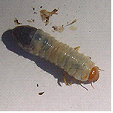 Note dark area on larva
Note dark area on larva
Susceptible Plants
There are many plants that are attacked by this pest including dahlias and petunias. Vegetables such as tomato, beetroot cabbages and cauliflowers are also attacked. Potted plants in gardens or in a nursery situation may become infested, drastically reducing the vigour of the plant.
Turf Grasses are susceptible to infestation causing greens to become bumpy and a secondary damage is caused by birds fossicking for grubs and the adult beetles emerging at night to feed.
There are several types of Scarab Grubs including the Blackheaded Pasture Cockchafer (Aphodius tasmaniae), which feeds on the leaves that it collects and stores in vertical soil tunnels for up to a week. It then returns at night after rain to collect more leaves.
Other species include the Argentinian Scarab (Cyclocephala signaticollis), Brown Cockchafer (Ataenius imparalis), Prinrose or Lawn Scarab (Sericesthis germinate) and the Readheaded Cockchafter (Adoryphorus couloni). All of these species cause sporadic damage to Turf Grass.
Control
Cultural Control
It is difficult to rid lawn areas of this pest using cultural methods. Garden lighting attracts the adult beetles.
Biological Control
Nematodes (Heterorhabditis zealandica) Birds with large beaks such as magpies feed actively on exposed larva but they can cause damage by their feeding to turf areas.
Areas may be forked to reveal the lava, particularly during spring when they are close to the surface.
Chemical Control
Insecticides may not be economic unless the larvae are in a confined area such as a pot
Various insecticides are available. There has been some success with the use of small amounts of eucalyptus oil diluted in water and applied to the infected area when the adults are seen in Spring as the larvae are close to the surface.
Note
It is your responsibility by law to read and follow the directions of any pesticide
Monitoring
Pit fall and light traps for the adults.
Soil cores for the larva
Amendments by B. Sonsie Dip Hort Sc Burnley
PEST
NAME
Cutworms
Agrotis species
ORDER
Lepidoptera
FAMILY
Noctuidae
Description of the Pest
Cut worm larvae live in the soil, congregating in weedy areas; they chew off young seedlings at the base. They are smooth, thick fleshy grubs that vary in colour, from pinkish brown to olive green, or almost black. They grow up to 40mm long and 5mm thick. Larvae curl up when disturbed, pretending to be dead. Larvae burrow down into the soil to a depth of about 50mm to pupate. Adults are dark brown, hairy moths, with a wingspan of about 60mm.
These insects have a Holometabolous life cycle, ie. When metamorphosis is observed during the pupal stage.
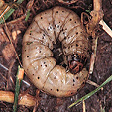
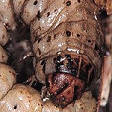
Appearance of the Pest
Adult moths are strong fliers capable of flying many kilometres laying eggs over a wide area. The eggs may remain dormant for several weeks until it rains or emerge within a few days under the right weather conditions.
Three similar species are commonly found in Australia:
· Agrotis ifusa (Bogong moth) is up to 50mm across and has three spots on its forewing.
· Agrotis munda (pink cut worm); and
· Agrotis ipsilon (black cut worm).
 Agrotis munda
Agrotis munda
Period of Activity
Different species are active throughout the year, their prevalence being determined by rainfall and temperature. They are normally most active at night. Larvae will appear in greatest numbers when favourable environmental conditions produce lush growth.
Susceptible Plants
Cutworms prefer soft, succulent seedlings or fleshy annuals, perennials and a variety for ferns or orchids. They feed at night and remain in the soil during the day. They are most commonly found in soil that is infested with weeds or soil that is poorly drained and moist. Well-drained soils harbour less lava.
Senecio and Dianthus species are attacked by the Cutworm (Peridroma margaritosa) which eats seedlings, leaves and flower buds. Under glasshouse conditions all stages of the lifecycle are present.
Turf Grasses are attacked by several Agrotis species causing damage during different seasons according to there individual life cycle. All feed at night on the leaves when young and mature larvae shear plants stems at ground level.
Damage Caused
Young larvae feed on the lower epidermis of leaves. Adults attack stems and seedlings at the base, eating the soft new growth, on one side, or completely through. The damaged plant normally topples over (hence the common name). Mature plants may wilt or the foliage becomes yellowish as a result of the damage, but normally recovers.
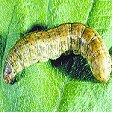
Cultural Control
Weed removal and cultivation to improve the drainage of the soil will provide some reduction in of numbers. Seedlings may be protected by a physical barrier, (eg plastic tube pushed into the soil around the seedling). Heavily infected soil can be laid fallow with for several weeks to disrupt the life cycle or the soil can be covered in black or clear plastic until weeds and lava are dead.
A molasses based bait that has hardwood sawdust and bran mixed with water creates a stick mass that the lava is attracted to but cannot escape. At sunrise they die from dehydration.
Biological Control
Natural predators such as birds, ground beetles and certain bugs help keep numbers down. Wasps and certain species of flies also attack the lava.
Encouraging earthworms by mulching and increasing the humus level is an excellent way to rid the soil of lava.
Chemical Control
Chemical treatment (Carbaryl) may be effective if sprayed in the evening, when the caterpillars emerge to feed.
Note
Always read the label for registration details and direction of use prior to application of any chemicals.
PEST
NAME
Lawn Armyworm
Spodoptera species
ORDER
Lepidoptera
FAMILY
Noctuidae
Description of the Pest
The larvae are fleshy caterpillars, up to 50mm long, with dark greenish-brown smooth bodies, having a pair of paler lines down their length, with patterns (triangular, in some species) in between. Larvae hide in the thatch of lawns, leaf litter, or under the surface of the soil during the day, emerging to feed at night. Larvae curl up when disturbed. Adults are grey brown moths, with a 40mm wingspan.
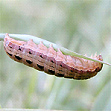
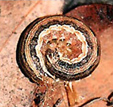
Appearance and Distribution of the Pest
An Australian native coastal species that is distributed by flying adults that are assisted by wind.
Life Cycle
These insects have a Holometabolous life cycle, ie. When metamorphosis is observed during the pupal stage.
Eggs are laid in clusters on the undersides of leaves; larvae pupate in the ground.
Period of Activity
Most active during warmer months, with vigorous plant growth following rain.
Damage Caused
Larvae feed in large numbers, chewing on the leaves, stems and flower heads to ground level, and migrating en masse to another area when the food source is exhausted.
Susceptible Plants
Turf grass species such as Pennisetum clandestinum (Kikuyu) and Cynodon species (Couch) are susceptible. Lawn armyworm will also attack cereal crops.
Cultural Control
Small numbers may be removed by hand.
Biological Control
Birds and parasitic wasps feed on mature larvae (ie after initial damage to host has been done), and are thus not an effective control.
Chemical Control
Spray lawn with Carbaryl (do not water in).
Note
Always read the label for registration details and direction of use prior to application of any chemicals.
PEST
NAME
Couchgrass Mite
Various Mite Species
ORDER
Acarina
Description of the Pest
There is a range of mites that cause 'Witches Broom' in couch such as (Dolichotetranychus australianus). The microscopic mites have eight-legs.
They have rasping mouth parts and the mites have a gradual metamorphosis.
Appearance of the Pest
They initially appear in the sheaved base of the leaves but are no normally noticed until the grass forms untidy thickets.
Period of Activity
Most active during hot dry periods, from the tropical to temperate regions, where it may remain active throughout the year.
Susceptible Plants
Turf Grasses are susceptible to several species of Mite such as the Couch Grass Mite (Oolicteranychus austrianusa), Grass Webbing Mites (Oligonychus species) and the microscopic size Eriophyid Mites (Eriophyes species), which forms no web.
Generally the insects attacks the growing tip of the grass causing the plant to be stunted or forming 'Bunchy Top' with a proliferation of leaves and yellowing of the foliage. This damage can be severe and the lawn recovers slowly. Infestations are most damaging during summer and the Couch Grass Mite infests Cynodon dactylon (Couch) and Digitaria didactyla (Blue Couch).
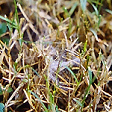 Grass Webbing Mites
Grass Webbing Mites
Image by B. Sonsie
Grass Webbing Mites attacks Cynodon dactylon (Couch), Digitaria didactyla (Blue Couch) and Stenotaphrum secundatum (Buffalo).
Eriophyid Mites (Eriophyes species) attacks Pennisetum clandestinum (Kikuyu) and Agrostis palustris (Bent)
Damage Caused
The insects reduce the internodal spacing and the emerging leaves are closely packed, giving a broom-like appearance. The leaves become mottled then turn brown and die. Runners fail to develop reducing coverage and the infected areas are predominantly along the margins of the lawn, against or over walls.
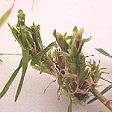 Damage on turf
Damage on turf
Control
Heavy rain will reduce numbers significantly, as will frequent overhead watering. Cut off and destroy infected areas and promote growth with fertilising and regular watering.
Chemical Control
Areas may be sprayed with wettable sulphur or dicofol. The mites are well protected and difficult to kill.
Note
Always read the label for registration details and direction of use prior to application of any chemicals.
PEST
NAME
Scale Insect
Various Scale Species
ORDER
Hemiptera
Description of the Pest
Generally scales are soft bodied insects that have a hard (armoured) or soft covering to hide under. They have piercing and sucking mouth parts that are attached to the host, feed off sap and soft scales commonly producing sweet honeydew, which in turn attracts sooty mould and ants.
The adult female has a circular or oval covering depending on the species and is up to 8mm across. The first stage (crawlers) hatch and wander around the leaf surface until finding a suitable place to suck sap, normally in colonies and the smaller male is relatively inconspicuous.
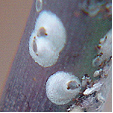 Hard Scale
Hard Scale 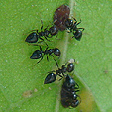 Soft Scale, attending Ants
Soft Scale, attending Ants
Cactus Scale (Diaspis echinocacti) has a circular greyish female and a narrow white male scale and is commonly found on house plants.
Chain Scales (Pulvinaria species) adult females are obvious with large group of eggs that are white or cottony-like, and the tiny young light green scales are flat and oval-shaped up to 2mm long. The legged nymphs are normally arranged from head to tail along the mid rib of the leaf, and may move to a new position to feed. They excrete honeydew and attract sooty mould and are found on Acacia and Acronychia species.
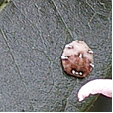 Chinese Wax Scale
Chinese Wax Scale
Chinese Wax Scale (Ceroplastes sinensis) is a domed wax scale that has dark spots around its margin and immature scales form waxy material around there margins.
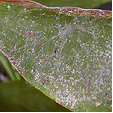 Fern Scale on Aspidistra elatior
Fern Scale on Aspidistra elatior
Fern Scale or Coconut Scale (Pinnaspis aspidistrae) appears as flecks up to 0.15mm long with a white covering over the male congregating on the underside of the fronds on the axils and among the sporangia causing them to turn yellow. Many species of fern are susceptible to infestation.
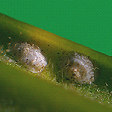
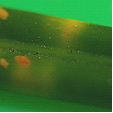 Flat Brown Scale
Flat Brown Scale
Flat Brown Scale (Eucalymnatus tessellates) are light brown up to 0.5mm long, flat and closely attached both sides of the leaf and causing yellowing of the foliage.
Juniper Scale (Diaspis carueli) is tiny and circular, white maturing to grey-black and as it feeds the needles turn yellow and die.
Oleander Scale (Aspidiotus hederae) is a pale yellow circular scale up to 3mm across and is found in dense colonies on the stem or leaves.
Tea-tree Scale (Eriococcus orariensis) are a creamy blue colour normally packed along the branches and are plump and rounded to 4mm across.
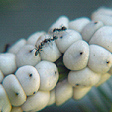
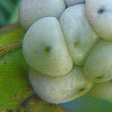 Wattle Tick Scale
Wattle Tick Scale
Tick or Wattle Scale (Cryptes baccatus) adult is domed, blue-slate colour with a leathery covering up to 10mm long. All stages of growth are found in groups of over forty, packed along the stems and normally tended by ants as they produce large amounts of honeydew. A serious pest of Acacia species found inland or coastal from temperate to sub tropical climates and commonly accompanied by Sooty Mould.
Toxic Scale (Hemiberlesia lataniae) is a tiny flat rounded scale up to 0.15mm long and is white to pale pink. It is normally found in colonies on the small branches and twigs of shrubs. It injects a toxic substance into the host as it sucks sap causing the death of the branch.
Wattle Scale (Pseudococcus albizziae) is soft, plump and secrets cotton-like threads. It is not a true scale insect and is simular to mealy bugs. It is reddish-brown up to 0.4mm long and secrets large amounts of honeydew as it sucks sap in colonies along the branches.
Life Cycle
These insects have a Hemimetabolous life cycle, ie. When the immature nymphs resemble the adults.
Appearance of the Pest
All parts of the plant above the soil may be attacked, but normally the stems and leaves and scale tends to favour well-lit positions.
Period of Activity
The nymphs and females are active for most of the year, in warm climates. Once they selected a position they attach and don't move. Normally the winged or wingless males are mobile and only soft scales produce honeydew.
Susceptible Plants
There is a wide range of susceptible plants including citrus, willows, holly, and many ornamentals, such as roses or Paeonia species. It also attacks indoor or glasshouse plants and Australian native plants such as wattles, hakeas, grevilleas and eucalyptus.
Acacia species are attacked by the Tick or Wattle Scale, which infest twigs and small branches and heavy infestations will kill the host plant.
Acer species are attacked by the Cotton Maple Scale (Pulvinaria innumerabilia) which prefers Acer saccharinum. Nymphs first attack the leaves and the brown adult scale is covered in a woolly mass up to 14mm across, normally found on the underside of the stems and twigs.
Acmena smithii, Melaleuca, Syzygium and Pittosporum species are attacked by the Chinese Wax Scale.
Aesculus species are attacked by several scale insects including the Walnut Scale (Aspidiotus juglans-regiae) which is saucer-shaped and attacks the main trunks.
Agave species are susceptible to several types of scale including (Aspidiotus nerii), (Aonidiella aurantii) and (Pinnaspis strachani), but generally do not require control.
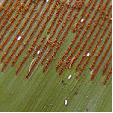 Asplenium australasicum
Asplenium australasicum
Asplenium australasicum is susceptible to Coconut Scale or Fern Scale (Pinnaspis aspidistrae). It is normally found on the under side of the fronds. Small infestations cause little damage.
Bougainvillea species may be attacked by the soft scale (Coccus hesperidum) outdoors or under glass.
Calluna and Vaccinium species are attacked by the Oyster Shell Scale (Lepidosaphes ulmi).
Camellia species may be attacked by the Florida Red Scale (Chrysomphalus aonidum), which is small, circular and black and is found firmly attached to the underside of the leaf along the veins. On inspection after removing the scale the insect has a pale yellow body. Camellias are also attacked by a large variety of scale insects including Tea Scale and Camellia Scale.
Carpinus species may be attacked by the scale (Phenacoccus acericola). It is found on the underside of the leaves forming a white cotton-like clump along the veins.
Casuarina and Allocasuarina species may be attacked by the Casuarina Scale (Frenchia casuarinae), a black hard scale that is upright to 4mm with a pinkish body. During attachment the surrounding tissue swells up and in time can, form galls. This weakens the wood and in severe infestations may kill the tree.
Cotoneaster species are attacked by up to four species of scale including the Oyster Shell Scale (Lepidosaphes ulmi).
Cupressus species are attacked by Bark Scale (Ehrhornia cupressi) is pink and covered in white wax. Heavy infestations cause the leaves to turn yellow or reddish.
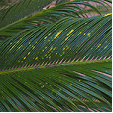 Flat Brown Scale on Cycas revoluta
Flat Brown Scale on Cycas revoluta
Cycads, palms and some species of Callistemon are attacked by the Flat Brown Scale.
Erica species are attacked by several species of scale including, Greedy, Oleander and Oystershell scale.
Jasminum species can be infested with up to twelve types of scale.
Juniperus x media and other conifer species are attacked by the Juniper Scale.
Leptospermum species are attacked by the Tea-tree Scale which produces ample honey dew that promotes sooty mould.
Palm and Fern species are susceptible to attack by the Coconut Scale or Fern Scale (Pinnaspis aspidistrae) which infests the underside of the leaves. They are also hosts for many other scale species such as red, cottony cushion and tea scale.
Pinus species are attacked by several species of scale including the Pine Tortoise Scale (Toumeyella numismaticum) and the Red Pine Scale (Matsucoccus resinosae).
Polygonum odoratum is attacked by a small brown scale.

Sorbus aucuparia is attacked by a five species of scale insect, including Black Cottony Maple, San Jose and Scurfy. Generally they suck on the sap of the new growth and leaves.
Strelitzia species are attacked by the Greedy Scale (Aspidiotus camelliae).
Damage Caused
Leaves become yellow and are shed prematurely and there may be twig or stem die-back. When the infestation occurs on fruit, the fruit is small and its skin becomes pitted and cracked. Small trees and saplings that are heavily infested may be seriously damaged or die. Sooty mould can cover fruit or leaves causing a secondary problem.
Cactus Scale can completely cover the host cactus sucking sap and causing it to die.
Cultural Control
Dead or damaged parts of the plant should be removed and destroyed including fallen fruit. Small infestations may be removed by hand or squashed on the stems. Healthy plants are less susceptible to attack, so maintain vigour of the plant and avoid using high-nitrogen fertiliser that produces excessive soft young growth.
When pruning susceptible plants paint the cuts with antifungal sealant paint as scale insects are attracted to the sweet smell of the sap. This will reduce the infection rate of the plant.
Biological Control
Natural predators such as parasitic wasps may reduce numbers of active nymphs; parasitic wasps are bred commercially in some areas for this purpose. It should be noted, however, that wasps would avoid dusty conditions.
Other predators that assist in control are assassin bugs, ladybirds, lacewings, hover flies and scale eating caterpillars. A variety of birds also attack scales.
The control of ants that transport aphid from one host to another also reduces infestation and can be carried out by applying at least three greased bandages 5mm apart around the stem or trunk of the plant.
Chemical Control
Spray the entire plant with dilute white oil solution; a follow-up spray may be required after four weeks, for heavy infestations. Spraying of chemicals will also kill of natural predators and in some cases the secondary scale infestation is more prolific especially when using copper based chemicals.
Some chemical controls, such as methidathion, are available - please seek advice from your local nursery as to the suitable product for your area.
Note
Always read the label for registration details and direction of use prior to application of any chemicals.
PEST
NAME
Mole Cricket
Gryllotalpa species
ORDER
Orthoptera
FAMILY
Gryllotalpidae
Description of the Pest
Adults are brown, up to 45mm long, with thick, serrated forelegs (spade-like) for digging and cutting. Adults and nymphs have chewing mouthparts. The head and thorax are encased in a hard shell, while the abdomen is soft. Adults have wings, but are poor fliers; they are attracted to light.
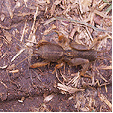
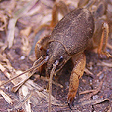
Appearance and Distribution of the Pest
Mole crickets are found in Africa, Eurasia and North America, and are common in the eastern States of Australia. They are subterranean feeders. An introduced species Scapteriscus didactylus The Changa mole cricket has become a major pest in Eastern Australia.
Life Cycle
These insects have a Hemimetabolous life cycle, ie. When the immature nymphs resemble the adults.
Eggs are deposited in the topsoil; nymphs and young adults live in the top 5cm of the soil. Mature adults live in tunnels up to 1m deep.
Period of Activity
Mole crickets are most active during the warmer months.
Damage Caused
Nymphs and adults feed on the roots of plants by cutting into them and leaving small raised ridges and the roots may be damaged when large numbers tunnel under the plant. Turf grasses can die as a result of heavy infestation. Tunnelling may dislodge seedlings.
Susceptible Plants
Many plants are attacked by mole crickets, especially turf grasses, vegetables and ornamentals. Seedlings may also be destroyed.
Cultural Control
No effective cultural control.
Biological Control
No effective control known.
Chemical Control
Spray lawns after rain or when the soil is moist as they move closer to the surface. with Diazinon or Phenthion.
Note
Always read the label for registration details and direction of use prior to application of any chemicals.
PEST
NAME
Fly Maggots
Delia species
ORDER
Diptera
FAMILY
Aleyrodidae
Description of the Pest
The adult Onion Fly Maggot (Delia antiqua) is a small grey-brown hairy fly to 5mm long and lays its eggs on decaying plant material. The ensuing whitish maggots are up to 8mm long, tapering towards the head and feed under ground.
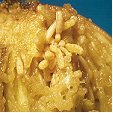 Onion Fly Maggot
Onion Fly Maggot
Life Cycle
This insect has a Holometabolous life cycle, ie. When metamorphosis is observed during the pupal stage.
It has up to two generations per year.
Period of Activity and Distribution of the Pest
This pest is found from tropical to temperate regions and is most active during warm weather. Adult flies are commonly seen hovering over garden beds that have had manure added.
Susceptible Plants
This pest attacks Allium species particularly onions. Beans, crucifers and cucurbits are also attacked.
Cynodon dactylon (Couch) turf grass is susceptible to the CouchTip Maggot (Delia urbana). The eggs are deposited by the small fly and the larvae are tiny white maggots that eat the growing points of the grass. It is only a serious problem when there are large numbers of maggots.
Damage Caused
The larvae tunnels into the stem of the host then moves to the below ground parts. Bulbs and roots are hollowed out causing the plant to turn yellow, wilt and collapse. Infected plants generally lack vigour. These holes allow a secondary infection to enter the plant.
Cultural Control
Correct soil preparation reduces infestation. Avoid planting in soil that has uncomposted organic material in it, particularly when it is dug into the bed. Mulching should be carried out during mid summer or in mid winter when the adults are less active.
This pest is difficult to eradicate and in an enclosed environment sticky fly paper can reduce numbers.
Biological control
There is no effective biological control.
Chemical control
The soil may be treated with primiphosmethyl to aid in control.
Note
Always read the label for registration details and direction of use prior to application of any chemicals.
PEST
NAME
Flea Beetle (General)
Various Flea Beetle Species
ORDER
Coleoptera
Description of the Pest
Adults beetles are small up to 4mm long and may be blue, brown, yellow or black with shiny wing covers. They have chewing mouth parts and normally long thick antenna. The hind legs are used for jumping, hence the description as a "flea beetle" and quickly jump when disturbed.
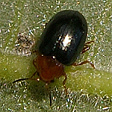
The Potato Flea Beetle (Epitrix cucumeris) is small and black eating small holes in young leaves.
Appearance and Distribution of the Pest
Larvae appear from summer through autumn and originated in Europe. They spread by flying assisted by the wind or are transported on infested plant material.
Life Cycle
These insects have a Holometabolous life cycle, ie. When metamorphosis is observed during the pupal stage.
Period of Activity
During the warmer months of the year.
Damage Caused
Larvae emerge in the stems of the plants. Shoot tips and the upper surfaces of leaves are holed by feeding adults and, as the leaves mature, the holes become enlarged, giving the plant a damaged appearance. Young plants and seedlings may be killed during heavy infestations.
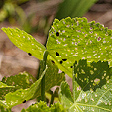

Susceptible Plants
Many plants are susceptible, including hibiscus, dahlias, grapevines, avocados, potatoes, sweet potatoes, rhubarb, and various weed species.
Alnus species are attacked by the Alder Flea Beetle (Altica Ambiens) which is a tiny green-blue beetle with brown lava that has a black head, and feeds on the leaves from spring to summer.
Cheiranthus species may be attacked by the Western Striped Flea Beetle (Phyllotreta ramose) which is black with a yellowish stripe down each wing cover and feeds on the leaves.
Myosotis and Primula species are attacked by the Potato Flea Beetle.
Turf Grass are susceptible to attack by the Flea Beetle (Chaetocnema australica), which is a dark coloured adult with strong rear legs for jumping and grows to 3mm long. Damaged areas have a brown wilted appearance but the damage is usually minor and is found during the warmer months.
Cultural Control
Sticky traps may be used.
Biological Control
None known.
Chemical Control
Spray with a contact chemical such as Carbaryl during infestations.
Note
Always read the label for registration details and direction of use prior to application of any chemicals.
PEST
NAME
Mealybugs
Various Mealybug Species
ORDER
Hemiptera
FAMILY
Pseudococcidae
Description of the Pest
Adult females are 3-5mm long, flattened oval-shaped white insects, which secrete a white, mealy wax that forms a row of hair-like filaments of fairly uniform length around the edge of the body; the hind end bears one or two pairs of filaments that are longer than the others. They are mobile but slow-moving. The seldom-seen adult males are tiny winged insects with a pair of long waxy tail filaments. Early stage nymphs are tiny, pink and mobile; later stages resemble adult females.
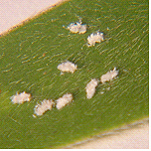
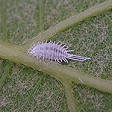
There are many types of mealybugs including;
· Longtailed Mealybugs (Pseudococcus longispinus) generally have tail filaments that are longer than there body. If squashed yellow body fluid is revealed and the eggs are laid under the body and normally hatch immediately.
· Citrus Mealybug (Planococcus citri). This insect has tail filaments that are less than 1/3 the length of its body. It produces yellow orange body fluid and lays eggs in a cottony mass.
· Citrophilous Mealybug ( Pseudococcus calceolariae). This insect has tail filaments that are about 1/3 the length of its body. It produces dark red body fluid and the eggs are laid in a cottony sac.
· Root Mealybug (Rhizeocus falcifer). This insect is not normally seen but produces a open white mass as it feeds on the outer or terminal roots, normally container plants, particularly cacti species. The eggs are laid in the waxy mass and adults may dispersed by ants.
· Hibiscus Mealybug (Maconellicoccus hirsutus)
· Tuber Mealybug (Pseudococcus affinis)
The Mealybugs (Pseudococcus adonidum) and (Planococcus citri) are a major pest of cacti species, sucking sap and turning the infected area yellow. These pests are also found on Strelitzia, Camellia and Yucca species.
Appearance and Distribution of the Pest
Mealy bugs are found worldwide. The above ground species are found in sheltered areas such as under a leaf or in leaf bases. They are also found where two fruits or leaves touch and are not readily noticeable.
The below ground species are only found when a plant is re-potted or the infected plant wilts and dies. Mealybugs are distributed several ways including slowly walking to a new host or transferred on clothing, contaminated plants or strong wind and on visiting insects. They are also farmed by ants which in a nursery situation infest pots by tunnelling and carrying mealybugs to the roots.
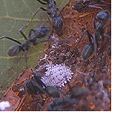 Attending Ants
Attending Ants
Life Cycle
These insects have a Hemimetabolous life cycle, ie. When the immature nymphs resemble the adults.
Up to 200 young are produced in 2-3 weeks; eggs may hatch as they are being laid. The life cycle includes eggs, nymphs (3 to 4 stages) to adult takes 6 weeks, in warmer months; several generations appear throughout the year.
Period of Activity
Active all year, particularly in spring and autumn. Warm, humid conditions are preferred and the insect overwinter outdoors as eggs. These may be found on surrounding weeds. In Citrus species many longtailed mealybugs overwinter as juveniles, maturing during spring. In a Glasshouse conditions mealybugs are active through the year.
Damage Caused
Adults and nymphs suck sap, congregating in sheltered parts of the plants; some species feed undetected on roots. Early infestations may go unnoticed until the plant begins to wilt. The insect also produces honeydew, which gives rise to sooty mould.
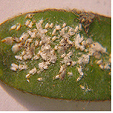
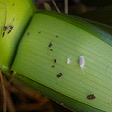 Clivia miniata
Clivia miniata
Susceptible Plants
Mealybugs are found on a wide variety of trees and shrubs. They are also destructive to many ornamentals; including indoor plants (especially African violets and ferns), and are a major greenhouse pest.
Cactus species
Many species of mealybug are common pest of cactus and succulents. The small, grey to light brown mealy bugs are difficult to see amongst the spines. Nesting females appear as the small balls of white fluff on cactus spines or around the base and under the rim of the pots. The female will produce eggs or living nymphs and the insect will produce honeydew that attracts ants. Ants should be discouraged as they farm mealy bugs, moving them from one place to another in a cactus collection.
Cactus is also attacked by the root mealybugs that infest the roots of plants and their damage allows fungal and bacterial infections to enter the plant tissue. They can be identified by white fluffy deposits in the soil or underneath a pot and appeared as tiny pinkish brown wood lice up to 3 mm long.
Catalpa species are susceptible to the mealybug (Pseudococcus comstocki) which is a wax covered mealybug that causes distorted growth of the branches and branchlets.
Fern species are commonly attacked by mealy bugs and can be recognised by small white, waxy secretions as it feeds in the crevices at vein junctions or on the exposed rhizome.
Hedera and Crassula species are susceptible to three species of mealybugs including Citrus Mealybug (Planococcus citri) and not normally requiring control.
Laburnum anagyroides is infested with the Grape Mealybug (Pseudococcus maritimus) infesting the branches and twigs.
Plumeria acutifolia becomes infested with mealybugs on the new growth but normally control is not required.
Psidium species are attacked by the Longtailed Mealybugs (Pseudococcus longispinus).
Sequoia species are attacked by three species of Mealybugs including (Planococcus citri).
Thymus species are attacked by the Root Mealybug (Rhizeocus falcifer).
Thuja species Cupressus macrocarpa and Araucaria heterophylla are can be infested with the mealybugs (Pseudococcus ryani).
Turf Grass may be infested with mealybugs causing severs damage and often go undetected and build up large colonies quickly. The turf forms brown dry patches and looks simular to Dollar Spot the infestation may also occur around core holes and can be discouraged by generous watering. Agrostis palustris (Bent) and Cynodon species (Couch) are commonly attacked.
Yucca species are attacked by the mealybug (Planococcus citri).
Cultural Control
Small plants may be sprayed with a soapy water solution or sponged down preferably during the evening. Heavily infected areas should be pruned and destroyed or the whole plant removed. Infested pot-plants should be discarded and thoroughly disinfect pots before recycling). Maintain vigour by watering to replace sap loss, this helps infected plants to recover.
As a preventative measure for root mealybugs grind up mothballs and add them to the potting mix to discourage infestations. Care should be taken as the chemicals in mothballs can damage plastic pots (use clay pots) and in some countries such as the UK. mothballs must be used as directed on the label.
Biological Control
Lacewing and ladybeetle larvae (Cryptolaemus montrouzeri) control small infestations. This predator insect requires temperatures of at least 21° C. (70°F) and in small infestations it is difficult to maintain a balance between predator and prey.
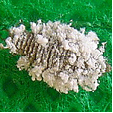
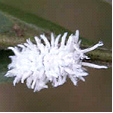
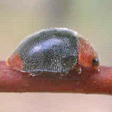
Ladybird beetle larvae eats Mealybugs Ladybird beetle up to 4 mm long
Chemical Control
Spray with white oil may have an effect on the population or spray Omethoate. Contact insecticides are usually ineffective because of the insect's protective waxy coating.
Note
Always read the label for registration details and direction of use prior to application of any chemicals.
DISEASE
NAME
Anthracnose (General)
Various Anthracnose Species
Description
This fungus is a casual organism that attacks leaves, flower, fruit, seed and twigs of the host.
Symptoms
Circular black spots appear primarily on the leaves or fruit but may also occur on the stems and flowers. The spots have a definite margin that may turn purple or black with age. As the spot enlarges the centre dries and may fall out giving the leaf a shot hole appearance or become sunken in some fruit while others form soft blackened areas. Infected leaves turn yellow then fall prematurely and fruit that is infected generally becomes black and rotten as it matures.
There are many variations in the symptoms depending on the type of plant and the species of fungus but generally as the fungal spots merge they form brownish to black dead areas.
Plane Anthracnose (Gnomonia platani) first appears on young leaves and as the leaves mature light brown spots appear along the veins and eventually engulf the entire leaf causing death. The twigs are also infected and often fall to the ground when dead and branches die after cankers appear lower down. This is a serious problem for Platanus occidentalis in North America.
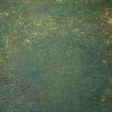 Anthracnose in turf
Anthracnose in turf
The Anthracnose (Colletotrichum species) and (Microdochium bolleyi) infects winter Turf Grasses. At first yellow patches appears which turn red brown then the leaf blades turn whitish and die. This forms bare areas and (Colletotrichum species) forms spine-like fruiting bodies that are tiny and can only be seen using a hand lens.
Wither Tip (Colletotrichum gloeosporioides) forms spots on the leaves and flowers and the stems form cankers that cause wilting at the top of the branches. Commonly found on Aucuba species.
Source and Dispersal
The fungal spores are dispersed by wind from infected plants or parts of plants. It is also dispersed by splashing water or contaminated stock.
Favoured Conditions
The fungus prefers cool humid climates and is not commonly seen in warm coastal regions and may continue living in dead wood, leaf litter or harvested fruit.
Affected Plants
The Anthracnose species is found shrubs, vegetables, trees particularly fruit trees such as mango or macadamia and large trees such as Platanus species.
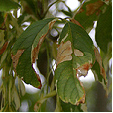
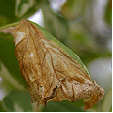 Acer negundo
Acer negundo
Acer species are infected by the Anthracnose (Gloeosporium aporcryptum). Irregular shaped light brown spots appear on the leaf, joining to form large dead brown areas and giving the leaf a scorched appearance. Leaves may be fully or partially damaged, often causing the leaf to die prematurely. During constant wet weather this can become a serious problem. Acer saccharinum (Silver Maple) and Acer negundo (Box Elder) are particular susceptible and small plants may be sprayed with a fungicide as the new foliage appears to help control infection
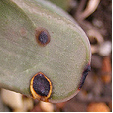
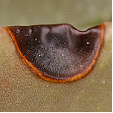 Agave species
Agave species
Agave species are susceptible to Glomerella Leaf Blight (Glomerella cingulate). This causes dark coloured depressed spots to appear on the leaves. The leaf apex dies and the spreading rot in Orchid species can infect the pseudobulbs causing the death of the plant.
Orchids such as Cattleya, Cymbidium, Cypripedium, Dendrobium, Epidendrum, Oncidium, Paphiopedilum, Phalaenopsis and Zygopetalum species are infected by Glomerella Leaf Blight (Glomerella cingulate).
Agrostis palustris (Bent Grass) is particularly susceptible to Anthracnose (Colletotrichum species) and (Microdochium bolleyi), but this fungal problem is also found on Cynodon dactylon (Couch), Lolium perenne (Ryegrass) and Festuca arundinacea (Tall Fescue). These grasses are infected in areas of poor drainage or where leaf wetness is prolonged. Low soil fertility may also contribute to infection and it is commonly found in coastal regions.
Anthurium species are susceptible to the Anthracnose (Gloeosporium minutum) which causes circular spots on the leaves, along the margins. These meld together forming dead brown areas that dry and fall out. It is commonly found in a glasshouse situation. The spadix is also infected by Spadix Blight (Colletotrichum gloeosporioides) which forms dark spots that enlarge, spoiling the flower.
Antirrhinum species are susceptible to the Anthracnose (Colletotrichum antirrhina) which attacks stems and leaves forming sunken oblong spots that are yellowish with a brown margin.
Cactus species are susceptible to anthracnose causing shot hole disease, which attacks the pads of Opuntia species (prickly pear). It appears and during the hot humid months of the year and is distinguished by the appearance of small brownish spots that turn grey with black spores under the drying skin. Control methods include removal of infected pads and treating wounds with disinfectant.
Digitalis species are infected by the Anthracnose (Colletotrichum fuscum). This fungus forms rounded spots that are purplish-brown and may have a purplish border. Fruiting bodies appear in the centre as the spots enlarge.
Leucadendron and Leucospermum species are susceptible to Anthracnose (Colletotrichum gloeosporioides). This causes the new growth to die back, leaf spots appear and cankers to form on the stems. It also causes damping-off of seedlings, which can be a major problem for Protea species as the fungus can be carried in the seeds.
Limonium species are infected by Wither Tip (Colletotrichum gloeosporioides). This is a serious disease causing spots on the leaf, flower and stems or rotting the crown.
Ribes species are attacked by (Pseudopeziza ribis). This infection causes circular brown-black spots on the leaves and premature defoliation of the plant. The spots may also appear on the petioles or stems. Infected areas may be sprayed with wettable sulphur weekly.
Schizanthus species are infected by Anthracnose (Colletotrichum schizanthi) which forms eater soaked areas on the stems and petioles, preferring new growth and maturing with canker-like lesions that girdle the stems.
Tilia species are infected by the anthracnose (Gnomonia tiliae), which forms light brown spots on the leaf venation, towards the tip and can defoliate an entire tree.
Spot Anthracnose (Elsinoe ilicis) infects Ilex cornuta forming black spots that may lead to leaf disorder. Opuntia species are infected by (Gleosporium cactorum) in warmer regions.
Vaccinium ovatum is infected by (Gloeosporium minus) and commonly known as Fleck and appearing on the leaf and stems.
Viola species are infected by (Colletotrichum violae-tricoloris) which produces brown blotches with black margins on the leaves.
Non-chemical Control
Avoid watering plants from above or wetting the foliage especially in the late afternoon. When planting allow space between each plant for good air circulation. Remove affected foliage or wood by pruning and dispose off site.
Turf grasses should have well drained soils, high fertility and avoid excessive watering to reduce possible infection.
Chemical Control
Regular spraying where possible during the periods that are favourable for fungus development. Fungicides include;
Systemic types, Biteranol, carbendazim, triforine
Protectants; chlorothalonil, copper oxychloride, mancozeb, thiram, zineb
Note
Always read the label for registration details and direction of use prior to application of any chemicals.
DISEASE
NAME
Fungi (General)
Various Fungal species
Description
A fungus is a plant that lacks chlorophyll and conductive tissue. Generally they are made up of branched threads called 'hyphae' and collectively form a vegetative body called 'mycelium'. The fungus is small but the fruiting bodies can become very large up to 600mm across such as bracket fungi or mushrooms. Common fungi are mould and mildews. problem that attacks the roots causing them to rot.
Fungus can reproduce many ways but primarily it is asexually, simular to cuttings of a plant and often occurs with minute portions of the mycelium (spores) separating. The spores can be arranged in a structure such as a sporangia or pycnidia or develop without an enclosed structure called a "conidia". Either way the fungus propagates very rapidly. Sexually reproduction occurs when two nuclei unite and form sexual fruiting bodies (zygospore).
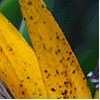 Strelitzia reginae flower
Strelitzia reginae flower
Symptoms
Fungus attacks all the above or below ground level parts of the plant living within the tissue of the plant and are very small and not normally detected until the fruiting body appears. However parasitic types such as powdery mildew or rust are visible on the outer surface of the plant.
Fungi hyphae may be divided by cross walls and known as "septate" while others with no cross walls are known as "nonseptate". These are the fungi responsible for cell leakage as in rot.
Back Mold (Chalariopsis thielavioides) affects understocks of grafted Rosa species by inhibiting the development of callus. It is whitish-grey maturing to black and can be found in the pith of the rose stem.
Black Root Rot (Chalara elegans).This recently introduced fungal disease in Australia (1993) affect plants by blackening the root systems and turning leaves yellow or purple. It is difficult to identify specifically as other pathogenic root diseases and nutritional deficiencies have simular characteristics.
The asexual spores are dispersed by wind or water. It is also transmitted on insects and in contaminated growing media or plants preferring humid moist conditions.
This fungus affects a wide range of ornamental plants including; annuals, perennials and shrubs. Examples are Begonia, Boronia, Camellia, Cyclamen, Fuchsia, Gerbera, Grevillea, Impatiens, Pansy, Petunia, Rosa species and Snapdragon.
Black Stem Rot (Pythium splendens) normally is a rot that occurs in cuttings turning the stem progressively black and shrunken. The leaves fall and the plant becomes stunted, eventually dieing.
Bleeding Necrosis (Botyosphaeria ribis) attacks and kills the inner wood causing the bark to split open and bleed sap giving it an oily appearance.
Blight (Endothia parasitica) is a serious pest of Castanea species, entering the twigs and small branches, and then progressively travelling throughout the tree killing it. It may form cankers on the base of the trunk or in the dead branches above with the amber coloured fruiting bodies pushing there way through the bark.
Copper Web ((Rhizoctonia crocorum). This fungal disease appears in defined patches causing the corms in the centre to become a black powdery mass. Corms on the outer ring of the patch that are partially infected forming a felty mass of violet threads on the corm scales. These threads extend into the soil and large sclerotia forms in the soil and on the corms. Healthy corms become infected from contaminated soil that contains mycelium and sclerotia.
Dry Rot (Phyllosticta concave) forms small circular spots that increase to a diameter of 30mm, and then becomes sunken as the cells collapse. The infected area develops minute black fruiting bodies.
Dutch Elm Disease (Ceratocystis ulmi) is a serious fungal problem of Ulmus species that initially causes yellowing then wilting of the leaves that turn brown and die. This may be seen on certain branches of the tree and on inspection under the bark the sapwood reveals brown streaks. A cross section of the affected branch displays round spots that are dark brown. This infection normally spreads quickly throughout, killing the tree in one to two seasons.
Dieback in Camellia (Glomerella cingulate) is a pathogenic fungus that infecting existing wounds such as leaf scars or mechanical damage, forming a sunken area (canker) that spreads around the stem causing die back. The affected plant has new shoots that are brown-black and the tips curl, forming a 'Shepard's Crook' appearance. The leaves also die but are persistent on the plant and the spores are found in soil or on other infected plants.
Curvularia Leaf Spot (Curvularia species) in Turf Grass. This is normally a secondary weak fungal infection that forms spots on the leaves that lengthens turning the leaves greyish. The leaf shrivels then dies and infected areas appear as weak patches in the turf. Preventive measures include minimising leaf wetness and excessive use of nitrogen fertiliser.
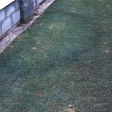 Fairy Rings Blue Couch
Fairy Rings Blue Couch 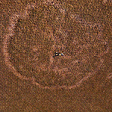
Fairy Rings are a fungal problem in Turf Grass and is caused by several species including (Lycoperdon species), (Marasmius species) and (Tricholoma species). Rings appear in the turf as fruiting bodies or dead grass and as lush green foliage. The mycelia expand radially in the turf feeding on soil nutrients and organic matter with water present.
Under severs conditions the mycelia consume all available nutrients resulting in the death of the turf. Lush turf can result from a less developed infection, where the decomposing hyphal releases nitrogen. This available nitrogen may be beneficial to the turf but some forms of nitrogen are detrimental.
Leaf Blister (Taphrina coerulescens) appears as yellowish circular raised areas on the upper side and depressions on the underside of leaves, up to 15mm across. As the fungus spreads the leaf dies but remains attached to the tree and this infection is commonly found on Quercus species..
Leaf Blotch (Guignardia aesculi) forms small or large water soaked spots that are reddish with a bright yellow margin and form black fruiting bodies in the centre. The affected leaf and petiole have a scorched appearance before falling, found on Aesculus species
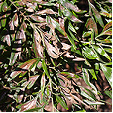 Grevillea robusta
Grevillea robusta 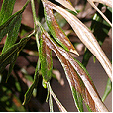 Leaf Scorch
Leaf Scorch
Leaf Scorch (Verrucispora proteacearum) is a fungal disease that infects leaves causing large parts of the leaf to turn grey-brown, giving the appearance that it has been singed by fire. Black fruiting bodies appear on the affected areas and the leaf soon withers then dies. New, mature leaves are affected during very wet periods towards the end of the branches and Grevillea and Hakea species are susceptible.
Melting Out (Helminthosporium vegans) forms bluish black spots with straw coloured centres on the leaves and may be found on the sheath, encircling it causing Foot Rot. It infects grasses particularly Poa pratensis. There is another fungus that is simular Helminthosporium Blight (Helminthosporium dictyoides) that infects Poa, Festuca and Agrostis species.
Pad decay (Aspergilus alliaceus) infects Cereus and Opuntia species and occurs at during periods of high temperature. The yellow spores at the epidermal layer through wounds and germinate on mass causing the area to become soft and spongy. An anthracnose called Shot Hole is a similar forming brownish spots the turn grey, and then black destroying pads. Control methods include physically removing damaged pads and allowing the Sun to heal wounds.
Potato Gangrene (Phoma foveate) is a soil borne fungus that infects the roots during harvest primarly through wounds and develops during storage. The potatoes rot from the inside forming rounded depressions on the surface and have a strong odour of rotten fish.
Root Rot Fungi (Phymatotrichum omnivorum) and (Pellicularia filamentosa) cause the roots to rot and the plant suddenly wilts then dies.
Root Rot (Pythium debaryanum) forms water soaked dark brown streaks that affect all parts of the plant causing wilting then dieing. It infects Ranunculus species, it also infects cactus species by forming brown spotting and wilting that appears at the base of the plant then extends towards the top. It quickly spreads from plant to plant in collections and is controlled by avoiding over watering, excessive humidity and are using a sterilised soil when potting up.
This fungus also is responsible for damping off of seedlings in a glasshouse environment.
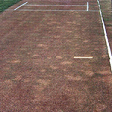 Spring Dead Spot
Spring Dead Spot 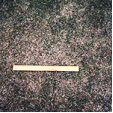
Spring Dead Spot (Leptosphaeri species) is a fungal disease that infects Couch Grass. It first appears during autumn as pale bleaches areas up to 500mm (20in) wide and persists throughout winter. In spring the affected areas do not recover or recover slowly and on inspection the roots or rhizomes are rotted. Runners from the surrounding healthy turf will help with recovery and all signs of the problem disappear by mid summer.
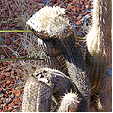 Cactus species
Cactus species 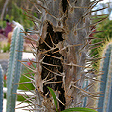 Pachypodium species
Pachypodium species
Stem Rot (Helminthosporium cactivorum) forms well defined yellow lesions that mature into soft dark brown rot. It commonly infects Cactus species entering through the stomates or wounds. Heavily infected plants collapse and die.
Stem Rot or Basal Rot (Pellicularia rolfsii) is a soil borne fungus that infects the stem root junction and extends into the leaves. In orchids the leaves become discoloured, dry and detach from the base which is covered in a fungal growth that produces sclerotia. The sclerotia is whitish to yellow then becoming dark brown and can be viable for up to four years.
White Mold (Ramularia desta f. odorati) occurs on both sides of the leaf and looks simular to powdery mildew but forms faint dull, reddish brown elongated spots on the leaf that may be depressed or along the margin where they have a watery appearance. Tufts of hyphae develop in the stomates.
Wilt (Ceratocystis fagacearum) causes leaves to curl then turn brown and the sap wood may also turn brown or black. Heavy infection may kill a tree within two seasons and is found on Quercus species and other ornamental trees.
Witches Broom may be a fungal problem that causes a proliferation of small axillary shoots to appear at the end of the branches. Little is known about this problem, though it affects a wide range of plants including Eucalyptus, Leptospermum and Pinus species.
Source and Dispersal
Fungus is found in the soil or on other infected plants and after releasing the spores, they are dispersed by wind or are transmitted in infected stock, insects and with splashing water.
Wilt is transmitted by infected root stocks, several species of insect and contaminated tools.
Dutch Elm Disease is transmitted by bark beetles such as (Scolytus multistriatus) and (Hylurgopinus rufipes). These beetles deposit eggs in the sapwood where the lava tunnel and pupate. The emerging beetles tunnel the bark and carry the fungus to fresh feeding sites on the tree. Infected beetles may also be transported to fresh sites in waist material.
Favoured Conditions
Prefers cool moist conditions with temperatures from 10º to 25ºC and is more common from autumn to spring when it is wet.
Affected Plants
A wide range of plants and all parts can be infected by various fungal diseases. Bleeding Necrosis is found in Liquidambar species and Stem Rot or Dry Rot infects Cactus species such as Opuntia and Pelargonium.
Abies species are infected by several fungi that cause Leaf Cast which turn the needles yellow to brown then fall prematurely.
Abutilon species are infected by the Stem Rot (Macrophomina phaseolin) affecting the lower stems and is not commonly seen.
Achillea, Cuphea, Leucanthemum, Euphorbia species are infected by the Stem Rot (Pellicularia filamentosa) which enters through the roots and rots the base of the stem.
Alternanthera species are infected by the Leaf Blight (Phyllosticta amaranthi) which forms small brown spots on the leaves causing them to curl and die.
Aloe, Astrophytum, Copiapoa, Echinocactus, Espostoa, Ferocactus, Gymnocalycium, Kalanchoe and Schlumbergerera species are infected by Bipolaris Stem Rot (Bipolaris cactivora). This infection affects many cacti species causing rot in the stems with a blackish appearance.
Amelanchler is affected by the Witches Broom (Apiosporina collinsii).
Antirrhinum species are infected by the Blight (Phyllosticta antirrhini) that forms light brown spots on the upper-side of the leaf and on the stem. As the spots enlarge they turn greyish with black fruiting bodies in the centre, then become brown and killing the affected areas.
Begonia species are infected by the Stem Rot (Pythium ultimum) turning stems black then becoming soft and causing the plant to collapse. This is the same fungus that causes Damping-off.
Betula species are affected by the Leaf Blister (Taphrina bacteriosperma) which curls the leaves and forms reddish blisters.
Chamaedorea and other cain-like species are infected with Gliocladium Stem Rot (Gliocladium vermoseni) which forms a dark basil stem rot generally on damaged plants and produces orange-pink spores. The mature leaves are first affected and eventually the stems or cains rot and die.
Crocus and Gladiolus species are infected by the Dry Rot (Stromatinia gladioli), which causes lesions on the corms and rots the leaf sheath.
Crocus, Iris, Tulipa, and Narcissus species are infected Copper Web ((Rhizoctonia crocorum).
Dianthus species are infected by Phialophora Wilt (Phialophora cinerescens) that causes the leaves to fade and plants to wilt. There is obvious vascular discoloration which is very dark. It is not found in Australia.
Erythrina x sykesii may be infected by the Root Rot Fungi (Phymatotrichum omnivorum).
Fern species are infected by Tip Blight (Phyllosticta pteridis). This blight produces ash-grey spots with purple brown margins and the fruiting bodies appear as black pimple like spots. It is transmitted by air or moisture and in infected fronds become brown and die. Control methods include sprang fungicide on leaves or reducing humidity and avoid wetting the fronds.
Forsythia species are infected by Stem Gall (Phomopsis species). It forms rounded growths along the stems causing them to die and look unsightly.
Gladiolus species are infected by Penicillium Rot of Corms (Penicillium gladioli). This disease forms deeply sunken reddish brown areas that become corky and produce a greenish fungal growth.
Hedera species are susceptible to several Fungal Leaf Spots including (Glomerella cingulate), (Phyllosticta concentrica) and (Ramularia hedericola). All of which cause yellowish spots that develop into dry brown blotches that kill the leaf.
Larix species are susceptible to Leaf Cast (Hypodermella laricis). This fungus attacks the needles and spur shoots turning them yellow at first then brown after which small black fruiting bodies appear on the leaves during winter.
There are several other fungi including (Cladosporium species) and (Lophodermium laricis) cause leaf blight or leaf casts.
Orchids such as Cattleya, Cymbidium, Cypripedium, Dendrobium, Epidendrum, Oncidium, Paphiopedilum, Phalaenopsis and Zygopetalum species are infected by Phomopsis Rot (Phomopsis species). This fungal problem forms a firm brown rot that appears on the leaves, pseudobulbs and rhizomes. The affected areas have yellow margins and the centre is covered in tiny black specks (fruiting bodies). Cattleya species are particularly susceptible. These plants are also infected by Psudobulb Rot (Mycolleptodiscus coloratus implicated). Dark spots appear on the pseudobulbs eventually causing extensive rot and killing the bulb.
Palms are infected by the fungus Butt Rot (Ganoderma sulcatum). The fungus entered the lower trunk normally as a result of mechanical damage (lawn mower). Symptoms include stunting of new growth and yellowing of the lower leaves. Fruiting bodies become evident at the base of the trunk. There is no effective control method and replanting in infected soil should be avoided.
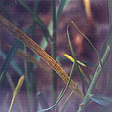 Kikuyu Yellows
Kikuyu Yellows 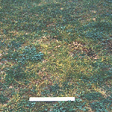
Pennisetum clandestinum (Kikuyu) is susceptible to Kikuyu Yellows (Verrucalvus flavofaciens), thisis a water mould that infects the roots and causes them to rot. The infection extends up the stem and onto the leaves with yellow discolouration and can be limited to a small or large area up to 1m (3ft) wide.
It is found in warm temperate to sub tropical regions and dispersed in infected soil or plant material. There is no chemical control, nitrogen fertiliser masks the symptoms and complete fertiliser encourages stronger roots to fight the disease.
Pittosporum, Antirrhinum, Aquilegia, Echinops and Orchid species are infected by the Stem Rot or Basal Rot (Pellicularia rolfsii) commonly in the northern hemisphere and preferring humid glasshouse conditions.
Solidago species are infected by the fungal Scab (Elsinoe solidaginis) which covers the leaves and stunts the growth of the plant. Young plants may be killed.
Trillium species are infected by the stem rot (Pellicularia rolfsii) and ( Ciborinia trillii). This normally occurs in wet soils and is detrimental to the plants life.
Tsuga species are infected by Sapwood Rot or Butt Rot (Ganoderma lucidum) and (Coniophora puteana), which attacks the sapwood close to the bark, towards the base of the tree. Commonly killing the host.
Tulipa species are affected Blue Mold (Penicillium species) and the fungus (Rhizopus stolonifer) causing rot in the bulbs.
Vinca species are infected by the soil born Root Rot (Pellicularia filamentosa) which rots the stems and roots.
Viola species may be infected with the Scab (Sphaceloma violae) which attacks all parts of the plant including the seed capsule forming yellowish spots that turn brown and in leaves fall out. Stems and petioles can be girdled killing the upper part.
Viola species are also infected with the Stem Rot (Myrothecium roridum) which attacks the stems at ground level causing them to become dry and brittle. The leaves show symptoms by turning purplish-black and this fungus also infects Alcea and Antirrhinum species.
Non-chemical Control
Generally remove and destroy any infected plants or plant parts, when replanting, avoid using susceptible species for 3 years. When growing crops space the plants to reduce the humidity and airflow and cultivate the soil to increase the drainage. Remove weed growth from around the susceptible plants.
Avoid over watering the surrounding soil which encourages fungal development. In the case of trees remove any infected branches and heavily infected trees should be cut down and removed. This infected material should be disposed or burnt. Damaged trees should have the wounds dressed and sealed as a preventative measure particularly for Dieback in Camellia.
Deter Potato Gangrene by planting clean stock and be careful not to damage the crop when weeding. When harvesting the tubers choose a dryer period and be careful not to damage them.
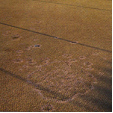
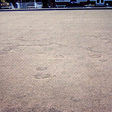 Fairy Rings
Fairy Rings
Fairy Rings in Turf are difficult to control and may appear or disappear sporadically. Cultural practice such as minimal thatch build-up, regular aeration and a reduction of organic matter spread on the turf will reduce infection.
Chemical Control
No suitable fungicides available, though drenching or spraying the soil with the fungicide dichloran helps control soil born fungi.
Note
Always read the label for registration details and direction of use prior to application of any chemicals.
DISEASE
NAME
Downy Mildew (General)
Various Downy Mildew Species
Description
Generally Downy Mildew may occur as a result of several fungal species, but have simular symptoms. The fungus is normally host specific.
Symptoms
The upper leaf forms yellowish, green or translucent patches that become enlarged and eventually the leaf turns yellowish-brown, wilts and dies. It can extend down the petioles onto the plant causing it to collapse and on the underside of the patches downy spores form, these may be grey to mauve or brown to purplish.
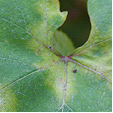
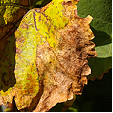
The Downy Mildew (Plasmopara halstedii) forms pale green spots on the upper surface of the leaves with corresponding white felty areas on the underside. The affected leaves contract, turn brown and die; commonly found on Senecio species.
Downy Mildew in Rose (Peronospora sparsa). Angular purplish to dark brown spots or areas develop on the upper leaf surface and under humid conditions, the underside of these areas develop fury fruiting bodies. Young and heavily infected leaves turn brown and fall. The flowers stalks and stems are also attacked with purplish blotches or streaks that may cause them to split. Young growth that is infected dies off and if the flowers are affected in bud blooms become deformed when open.
The spores overwinter on infected plants and fallen leaves and are dispersed by wind infecting new growth during spring.
Downy Mildew in Stocks (Peronospora parasitica). The upper leaf forms yellowish green patches that become enlarged and eventually the leaf becomes yellow, then wilts and dies. It also infects the stems and on the underside of the leaves patches downy grey to mauve-white pustules form where the spores are arranged in rows. This fungus is soil born and commonly dispersed by infected plants.
Source and Dispersal
It is normally found or dispersed on other infected plants. The spores are also spread by wind but are unable to germinate in dry conditions, requiring moisture on the leaf and a humid environment to grow.
Favoured Conditions
It prefers warm humid days with cool nights and spread quickly in closely planted seedlings or plants.
Affected Plants
A wide range of vegetables, annuals, perennials and shrubs are affected. Plants such as stocks and seedlings are at most risk commonly causing the plant to collapse and die.
Aster species are infected by the downy mildew (Basidiophora entospora).
Mathiola incana and Arabis species is infected by (Peronospora parasitica) causing stunting with downy mold on the underside of the leaves. Seedlings are at most risk commonly causing the plants to collapse and die.
Rudbeckia species are infected by the downy mildew (Plasmopara halstedii) causing yellowing of the foliage, wilting and in some cases death of the plant.
Turf Grasses are susceptible to the downy mildew (Scleropthora macrospore), which may not appear downy on the leaves but leaves affected are stunted, thickened or become broad and only under severe cases small yellow patches up to 100mm wide appear in the turf.
Veronica species are infected by the downy mildew (Peronospora grisea). Symptoms include leaves form pale spots on the upper surface while greyish mildew forms correspondingly on the underside.
Viola species ate infected with (Bremiella megasperma) which forms irregular greyish spots on the upper surface and felt-like growth on the underside.
Non-chemical Control
Infected plants must be removed and destroyed and avoid over planting seedbeds. Avoid watering from above or over watering to reduce humidity. When planting out space the plants to allow good air circulation as a dry atmosphere halts or reduces the infection. Select resistant plant species when planting.
Improve drainage and aeration of the soil in affected Turf grasses and avoid overwatering.
Chemical Control
With seedlings drench the soil with a systemic root absorbing fungicide such as furalaxy. Plants can be sprayed with a protectant fungicide such as copper oxychloride or zineb if the weather conditions are favourable for fungal attack. Be certain to thoroughly cover the under side of the leaves.
DISEASE
NAME
Fusarium Wilt (General)
Various Wilt Species
Description
Fusarium wilt is caused by specialised strains of the common soil fungus, Fusarium oxysporum.This fungus is microscopic, and that can live in the soil for many years and primarily attacks plants by entering through the roots. This affects corms, stems and leaves by moving through the water conductive tissue in the plant.
The specialised strains are known as formae speciales (f. sp. or special forms) and each f. sp. has a relatively narrow host range. For example Fusarium oxysporum f. sp. cubense causes Panama wilt of banana, F. oxysporum f.sp. vasinfectum infects cotton and F. oxysporum f. sp. lycopersici attacks tomatoes. Each strain is specific to that narrow host range and will not affect other hosts; this is important as it makes control options involving the planting of other plant species possible.
Symptoms
Generally the plant wilts quickly during hot weather or lacks growth and vigour. Typically the symptoms are often indistinguishable from drought stress. Leaves yellow and wither or stems split open near the base. Individual branches may collapse and die or entire plants perish. One of the distinctive symptoms is a one-sided yellowing and death of a leaf or branch. Corms become rotted with open wounds and affected stems, when split open are yellowish. There are variations in the symptoms depending on the type of plant but generally plants wilt, turn brown and die.
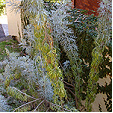
Basal Rot (Fusarium oxysporum) infects Tulipa and Crocus species by turning leaves reddish, which wilt and normally die. It also affects the bulbs by forming few roots and rotting the base, turning them dull white.
This disease also infects cactus such as Cereus species and Zygocactus truncatus causing soft black rot that appears at the tips of the plant then spread rapidly downwards. It is particularly virulent in hot beds, under glass. The infected plants cannot be cured and should be disposed off site.
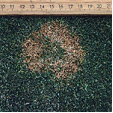 Fusarium Patch, Bent
Fusarium Patch, Bent  Fusarium Patch, Blue Grass
Fusarium Patch, Blue Grass
Other Fusarium (or related species) diseases
Fusarium Patch (Microdochium nivale formerly known as Fusarium nivale) is also known as Crown or Root Rot and infects warm or cool season Turf Grasses. The fungus infects the roots or rhizome turning them black, sometimes with a pink ting. During hot periods light green to brown patches appear in the turf as the damaged roots are unable to supply water to the leaves. This diseases is not a significant disease in Australia
Minimise irrigation of infected areas to reduce spread of infection as the spores are distributed in water.
Root Rot (Fusarium verticillioides) is a seed born fungus that infects Strelitzia reginae. It also forms a Leaf Spot in Dracaena species where rounded or irregular yellowish to reddish spots with a pail green border form. These are found on immature leaves and heavy infections may rot the crown.
Source and Dispersal
The fungal spores are dispersed by wind from infected plants or parts of plants. It is also dispersed by splashing water or contaminated stock or the movement of soil. With Fusarium wilt of canary island date palms the transfer of infected plant material on chain saws has been shown to be an important way in which the fungus can be transmitted from one tree to another. It is essential in these cases to sterilise the chain and chain bar between trimming the fronds on each tree.
Fusarium oxysporum produces three types of species, macroconidia, microconidia and chlamydospores. The latter two spore types play very important roles in the disease. The microconidia move in the vascular system of the plant and collect at the sieve plates in the xylem of plant. Here they germinate and grow and eventually block the sieve plate thus stopping the flow of water in the plant. The chlamydospores are specialised survival spores that persist in roots and in the soil for very long periods of time, thus allowing the fungus to survive periods when there are no susceptible plants present.
Favoured Conditions
The fungus prefers warm humid climates and is commonly seen in coastal regions and may continue living in soil for many years.
Affected Plants
Many species are infected including tomatoes, carnation, cucurbits and freesia. Die Back (Fusarium solani var. martii) causes damage to the branches of Ilex species. Fusarium also attacks palm species such as Phoenix causing wilt.
Albizia and Alternantera species are infected by the wilt (Fusarium oxysporum var. periciosum ) that causes the leaves to wilt, shrivel and die. This infection also extends to the branches and eventually may kill the tree.
Callistephus species are attacked by the wilt (Fusarium oxysporum f. sp. callistephi) which infects the vascular bundles turning brown, particularly on one side of the stem causing the plant to become stunted, eventually dieing.
Dendranthema and Thymus species are susceptible to the Stem Rot (Fusarium species) and (Pellicularia filamentosa) which rots the base of the stem.
Dianthus species are infected by Bud Drop (Fusarium poae). This fungus rots flower buds prior to opening and infected flowers open with distorted, unattractive petals. The control of thrips is essential. Dianthus species are also infected by Wilt (Fusarium oxysporum) that causes yellowing and wilting of the lower leaves, normally on one side. The infection causes stems to rot with vascular discolouration.
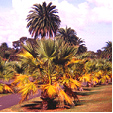
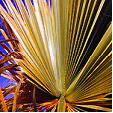 Fusarium Wilt Image by B. Sonsie
Fusarium Wilt Image by B. Sonsie
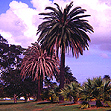
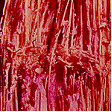 Image by Dr Brett Summerell
Image by Dr Brett Summerell
The only palms susceptible to Fusarium wilt are Phoenix species, especially Phoenix canariensis and juvenile Washingtonia filifera. Initially the leaflets turn yellowish then brown, on mature fronds causing them to die. Eventually only tufts of new growth remain the plant. As the infection continues the plant collapses and dies.
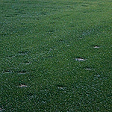 Fusarium Patch
Fusarium Patch
Turf grasses are infected by Fusarium Patch (Microdochium nivale). Plants include; Digitaria didactyla (Blue Couch), Cynodon species (Couch), Eremochioa ophiuroides (Centipede Grass), Festuca species, Paspalum vaginatum (Salt Water Couch), Pennisetum clandestinum (Kikuyu), Poa species (Bluegrass), Stenotaphrum secundatum (Buffalo) and Zoysia species. Generally the fungus produces small dead circular patches in the lawn.
Non-chemical Control
Fusarium diseases are extremely difficult diseases to control primarily because of a lack of a chemical control option and because the fungus is able to persist in soil for long periods of time. Crop rotation to non susceptible plants is advised and consequently it will be important to have the disease accurately diagnosed to ensure the identity of the pathogen and the possible rotation options.
Remove and destroy any infected plants. In the case of large trees or palms, it will be necessary to remove the infected plant, this not only means cutting down the above ground parts, but also removing the roots of the plant. These will then need to be removed and destroyed.
Fusarium Patch can be minimised by reducing thatch and aerating the soil regularly or improving the drainage.
Chemical Control
There are no effective chemical control options currently available for plant diseases caused by Fusarium species.
Note
Always read the label for registration details and direction of use prior to application of any chemicals.
Amendments by
Dr Brett Summerell
Director Science and Public Programs
Royal Botanic Gardens Trust, Sydney
DISEASE
NAME
Leaf Spot (General)
Various Leaf Spot Species
Description
There is a wide variety of fungal leaf spots that infect perennials, shrub and trees. Some are specific to the host while others can affect a range of plants.
Symptoms
Generally light brown to purplish or blackish spots appear on the leaf and form concentric rings of fruiting bodies. The spots may leave holes, perforating the leaf or expand with pale green to yellowish margins and when the holes merge the leaf normally dies. There are many different types of leaf spot, some are discussed below.
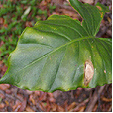 Alocasia species
Alocasia species 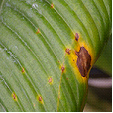
Alternaria Leaf Spot (Alternaria nelumbii) forms a small reddish brown spots that are boarded in light green, and as they develop in size the leaf curls and dies from the margin inwards. Normally occurs on Nelumbo species (water lilies).
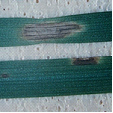 Helminthosporium Disease
Helminthosporium Disease
Helminthosporium Disease (Bipolris species), (Drechslera species) and (Exserophilum species) are responsible for several leaf spots that occur on all Turf Grass species. Generally they form black or white spots that may be faded and produce masses of spores in the thatch during late summer, under humid conditions. The life cycle is short and when conditions are favourable spores are splashed onto the foliage from the thatch, causing wide spread infection. Cynodon dactylon (common couch) is most susceptible and found in bowling or golf greens where it is a serious problem.
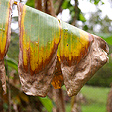 Banana Leaf Spot
Banana Leaf Spot 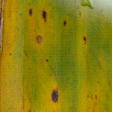
Banana Leaf Spot (Mycosphaerella musicola) is found on many species of banana causing pale yellow streaks on the young leaves to turn brown with dark spots. The leaf then becomes dried, brown and dead commencing from the margins, eventually the leaf dies. Control requires removal of infected foliage or the spraying of a fungicide and fungicides should not be used during the fruiting period.

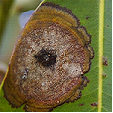 Lophostemon confertus (Brush Box)
Lophostemon confertus (Brush Box)
Leaf Spot on Brush Box (Elsinoe species). This is a casual fungus that attacks the epidermal layer of the leaf, forming circular spots that are up to 25mm across and are often restricted by the main vein. These spots are a dull yellowish brown but can also have purplish patterns. A leaf may have more than one spot develop on its surface and normally appears on scattered leaves throughout the tree. This doesn't affect the vigour of Lophostemon confertus.
Palm Leaf-scab (Graphiola phoeicis) appears as yellow spots and develop into scabs or warts that are outwards hard and dark but with a soft centre with powdery yellowish brown spores. The infected leaves eventually die.
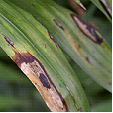 Palm Leaf Spot, Chamaedorea elegans
Palm Leaf Spot, Chamaedorea elegans
Palm Leaf Spot (Pestaloptiopsis species) appears as a small spot with a dark centre on the leaves and affects palms that are growing in shaded humid positions and normally control is not required, though infected fronds should be removed.
Source and Dispersal
Infection source is other contaminated plants and the spores are spread by wind or by splashing water. The fruiting bodies are black spots that appear on the damaged tissue releasing spores.
Favoured Conditions
This fungus prefers a warm humid environment and leafy plants with soft new growth, particularly if they are crowded.
Affected Plants
There are many ornamental and native plants that are hosts to a wide range of fungal leaf spots. Some specific ones are listed below. Plants such as Cornus or Paeonia species are infected by a large variety of leaf spots, while other plants attract a specific leaf spot.
Generally a healthy plant can tolerate fungal leaf spot attack, though it may make the plant look unsightly. In trees and shrubs it is difficult to control and generally not necessary, but in perennials and annuals control may be necessary in order to save the plant.
Acalypha and Arctotis species are infected by up to three leaf spots including (Cercospora acalyphae) and (Ramularia acalyphae) that rarely require control.
Acer species are infected by Purple Eye (Phyllosticta minima) which forms spots with brownish centres and purplish margins causing the death of the leaves.
Acer species are also infected by Tar Spot (Rhytisma acerinum) which forms round black spots that have yellow margins. Not normally seen on cultivated trees, but seen in forests.
Adiantum, Asplenium, Blechnum, Cyathea, Davallia, Nephrolepis, Platycerium, Polypodium and Pteris species are infected by the leaf spot (Pseudocercopora species) which forms circular brown spots on the fronds and heavy infection can defoliate a plant.
Aesculus species are occasionally infected with the leaf spot (Septoria hippocastani) which forms small brown spots.
Agave species are susceptible to the leaf spot (Coniothyrium concentricum), which appear as greyish spots up to 20mm (1in) across with concentric rings and black fruiting bodies. Affected leaves are destroyed as the infection spreads.
Albizia julibrissin is susceptible to the fungal leaf spot (gloeosporium aletridis), which does not normally require control.
Amelanchler, Chaenomeles, Crataegus and Rhaphiolepis species Mespilus germanica are infected by the leaf spot (Fabraea maculata) which may cause considerable damage during wet periods.
Aquilegia species can be infected by three types of Leaf Spot including (Ascochyta aquilegiae), (Cercospora aquilegiae) and (Septoria aquilegiae), normally appearing during humid conditions forming spots on the leaves.
Arbutus species are infected by two leaf spots (Septoria Unedonis) which produces small brown spots on the leaves and (Elsinoe mattirolianum).
Arctostaphylos manzanita is infected by the leave spot (Cryptostictis arbuti) which damages leaves but is not normally detrimental to the shrub.
Aspidistra species are infected by the leaf spot (Colletotrichum omnivorum) causing whitish spots on the leaves and petiole.
Aster species are infected by many leaf spots including (Alternaria species), (Cercosporella cana), ( Ovularia asteris) and (Septoria asteris).
Aucuba species are infected by several leaf spots, usually as a secondary infection after aphid attack. These include (Phyllosticta aucubae) and (Phyllostica aucubae).
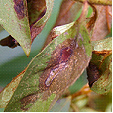
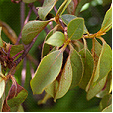 Azalea
Azalea
Azalea (Rhododendron species) are susceptible to Leaf Scorch (Septoria azalea). This fungal disease forms reddish- brown spots which expand and engulf the leaf, with fruiting bodies appearing in the centre. Infected leaves die, then fall and the branchlets wilt. This problem is more serious during wet periods and may require control using a fungicide.
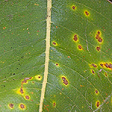 Banksia robur
Banksia robur
Banksia species are infected by several leaf spots causing chlorotic areas that have brown centres and is not normally a major problem for the plant.
Betula species may be infected by the Leaf Spots (Gloeosporium betularum) that forms brown spots with darker margins and (Cylindrosporium betulae) that also forms brown spots with faded indefinite margins.
Bougainvillea species are infected by the leaf spot (Cercosporidium bougainvilleae) which forms rounded spots with dark margins that yellowish ting. Infected leaves die and fall from the plant.
Calendula species are infected by the Leaf Spot (Cercospora calendulae) which rapidly infects the plant spotting the leaves and killing the plant.
Callicarpa species may be infected by the leaf spot (Atractilina callicarpae) forming irregular brownish spot or (Cercospora callicarpae) which can defoliate the plant in subtropical climates.
Campsis species may be infected by several fungal leaf spots including (Phyllosticta tecomae), (Septoria tecomae) and (Cercospora duplicata).
Carpinus species are infected by the leaf spots (Gloeosporium robergei), (Gnomoniella fimbriata) and (Septoria carpinea), all are minor infections not normally requiring control.
Carya species are infected by several leaf spots including (Gnomonia caryae) that infects leaves with irregular reddish spots on the upper surface with corresponding brown spore producing spots on the underside. It also has a secondary spore release that occurs on the dead leaves where it over winters. Other leaf spots include (monochaetia desmazierii) and (Marssonina juglandis).
Ceanothus species are susceptible to the leaf spot (Cercospora ceanothi) and (Phyllosticta ceanothi) both are of minor importance not requiring control.
Celtis species are infected by many leaf spots including (Cercosporella celtidis), (Cylindrosporium celtidis), (Phleospora celtidis) and (Septogloeum celtidis).
Chrysanthemums species are infected by the leaf spot (Septoria species) which forms yellow spots appear toward the edge of the leaves; these become enlarged brownish patches with yellow margins. Damaged areas may converge and in severe attacks and the leaves may fall prematurely or flower production is reduced.
Clematis species are infected by the fungal disease (Ascochyta clematidina) which may cause stem rot or leaf spots that are water soaked areas with reddish margins. The infection spreads from the leaves to the stem causing wilting and eventually girdling the stem killing the plant. There are many fungal leaf spots that infect this plant including (Cercospora rubigo) and (Septoria clematidis)
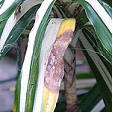 Dracaena deremensis
Dracaena deremensis
Cordyline and Dracaena species may be infected by the leaf spot (Phyllosticta maculicola) which forms small brownish spots that have yellowish margins and has black fruiting bodies that forms coils of spores. These plants are also susceptible to other leaf spots such as (Glomerella cincta) and (Phyllosticta dracaaaenae). Keep foliage dry to avoid infection.
Cynodon dactylon, Pennisetum clandestinum and many other Turf Grasses are susceptible to Helminthosporium Disease.
Daphne species are infected by the leaf spot (Gloeosporium mezerei) and (Marssonina daphnes) both of which form thickish brown spots that are seen on both sides of the leaves. Infected leaves turn yellowish before dieing.
Dendranthema species are infected by many leaf spots such as (Septoria chrysanthemi) which first forms yellowish spots up to 25mm (1in) across that become black. Infected leaves die prematurely and persist on the plant.
Dianthus species may be infected by the leaf spot (Septoria dianthi). It forms light brown rounded spots that have a purplish border. The scattered spots on the lower leaves can also be found on the stems and the spores are dispersed by water from the tiny black fruiting bodies.
Dieffenbachia species are infected by several leaf spot fungi including (Cephalosporium species) and (Myrothecium species).
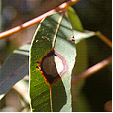 Eucalyptus species
Eucalyptus species
Eucalyptus species are infected by many fungal leaf spots such as (Mycosphaeralla species), (Hendersonia species) and (Monocheatia monochaeta). Generally leaf spots appear on the juvenile or new leaves causing brownish spots that enlarge and may have a purplish halo around the margin. Mature adult leaves are not normally infected and the trees rarely require control measures.
Fern species are infected by the leaf spot, (Alternaria polypodii). This fungus appears as brown circular or oblong spots that congregate along the margins of the pinnae causing the fronds to turn brown and die. It is spread by wind currents from plant to plant and control methods include removing infected fronds and maintaining a drier atmosphere.
Ficus species are infected by various fungal leaf spot including (Pseudocercospora species). Generally the fungal attack forms circular or irregular dark coloured spots on the leaves eventually causing them to fall prematurely.
Ficus elastica is susceptible to many fungal leaf spots including (Alternaria species), (Leptostromella elastica) and (Phyllosticta roberti).
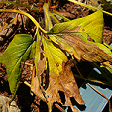
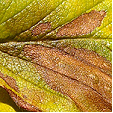 Strawberry
Strawberry
Fragaria x ananassa (Strawberry) is infected by the fungal leaf spot (Mycospharella fragariae). The mature leaf is initially infected with well defined brown spots that that turn light grey with red-purplish margins. As the spots merge they form large brown blotches and the leaf turns yellow then dies. This fungal attack normally occurs on plants in poor health and can be a serious problem early in the season seriously damaging stock.
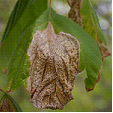 Fraxinus species
Fraxinus species
Fraxinus species are infected by the leaf spot (Gloeosporium aridum) giving the leaf a scorched appearance as large blotches appear from the margin or apex and turn brown with a papery texture. It is more prevalent during rainy periods and infected leaves fall prematurely. Collect and depose of fallen leaves otherwise control is not normally required.
Fuchsia species may be infected by the leaf spot (Septoria species) or ( Cercospora species), both form spots with dead centres and dark margins.
Gladiolus species are infected by Hard Rot or Leaf Spot (Septoria gladioli). On the corms reddish brown circular water soaked spots become large and sunken. These areas dry out and form obvious margins. The leaves may also have these symptoms but is not commonly seen.
Hemerocallis species are infected by several leaf spots including (Cercospora hemerocallis) and (Heterosporium iridis). These may be in the form of black spots or brownish spots that converge killing the leaf. Infected leaves should be removed and burnt.
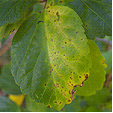 Hibiscus species
Hibiscus species
Hibiscus rosa-sinensis, Hibiscus syriacus and Hibiscus tiliaceus are susceptible to several fungal leaf spots including (Ascochyta abelmoschi), (Cerospora kellermanii) and (Phyllosticta hibiscina). All cause spotting or blotching of the leaf surface; remove and destroy infected parts.
Hydrangea species are infected by four fungal species including (Ascochyta hydrangeae), (Phyllosticta hydrangeae) and (Septoria hydrangeae).
Iris species are infected by several fungal leaf spots including (Alternaria iridicola) and (Macosphaerella species).
Iris species are also infected by the leaf spot (Didymellina macrospore) that forms greyish spots with brown water soaked borders and coalesce on the upper part of the leaf. This casual organism commonly occurs after flowering killing the leaves but will not infect the bulbs. The bulbs become weak over several seasons due to the decreased foliage.
There is also a Bacterial Leaf Spot (Bacterium tardicrescens) that is commonly mistaken as a fungal problem causing translucent spots that coalesce and involve the entire leaf. Normally found on Iris species.
Laburnum anagyroides is infected by the Leaf Spot (Phyllosticta cytisii). The leaf forms light grey spots with no definite margin and mature to brown. The black fruiting bodies appear as dots in the centre of the spot.
Leucanthemum species are infected by the leaf spot (Cerocspora chrysanthemi) and (Septoria leucanthemi).
Magnolia species are susceptible to many species including (Alternaria tenuis), (Mycosphaerella milleri) and (Phyllosticta species). Leaves generally turn brown from the apex or margins turning brown or spots appear on the leaf surface and leaves become yellow before withering and dieing. Normally the make the tree look poorly but have little effect on its growth. Control is not normally required.
Nerium oleander is susceptible to several fungal leaf spots including (Cercospora nerella), (Cercospora repens), (Gloesporium species) and (Phyllosticta nerii). Infected leaves should be removed but generally control is not required.
Nyssa sylvatica is infected by the leaf spot (Mycosphaerella nyssaecola) forming irregular purplish blotches.
Orchids such as Cattleya, Cymbidium, Cypripedium, Dendrobium, Epidendrum, Paphiopedilum, Phalaenopsis and Zygopetalum species are infected by several leaf spots including (Cerospora, Colletotrichum and Phyllosticta species). Normally forming dark or dead, circular or irregular areas on the leaves.
Palms such as Syagrus, Howea, Phoenix, Roystonea and Washingtonia species are infected by Leaf-scab (Graphiola phoeicis).
Palms such as Archontophoenix, Caryota, Chamaedorea, Cocos, Dypsis, Howea, Liculia, Linospadix, Livistona, Phoenix, Ptychosperma, Rhapis, Roystonea, Syagrus, Washingtonia and Wodyetia species are susceptible to several fungal leaf spots including;
(Bipolaris spp.), (Cylindrocladium spp.), (Colletotrichum spp.) and (Pestalotiopsis spp.).
Generally the circular leaf spots are brown and may have a yellow halo such as Palm Ring Spot (Bipolaris incurvata). They vary in size from small to large depending on the species. When a plant is healthy it recovers from attack, but heavy infections can defoliate, causing the collapse of the plant.
Palms are also infected by the Brachybasidium Leaf Spot (Brachybasidium pinangae). This fungus forms angular leaf lesions that produce fruiting bodies on the underside and is commonly found on Archontophoenix species.
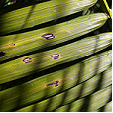
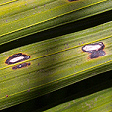 Archontophoenix cunninghamiana
Archontophoenix cunninghamiana
Passiflora species are infected with many types of leaf spot such as (Alternaria passiflorae).
Phoenix species are susceptible to False Smut (Graphiola phoenicis). This fungus forms yellow leaf spots that become hard with a raised with a blackish scab, which produces masses of powdery spores that are thread-like.
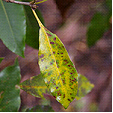
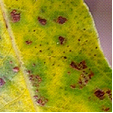 Pittosporum species
Pittosporum species
Pittosporum species are susceptible to the leaf spots (Alternaria tenuissima), (Phyllostica species) and (Cercospora pittospori). Circular or angular dark spots appear on the leaves and are surrounded by necrotic areas that are yellowish. Generally removal of infected leaves is adequate control.
Poa species and other cool season grasses are infected by Winter Fusarium Leaf Disease (Fusarium species), which causes small pale spots that are water soaked to appear on the leaves that turn red-brown. Infected leaves become bleached then wither and die, but the infection will not affect the crown or roots of the plant. It can be identified by pink, cotton-like mycelium and the plant prefers cold wet weather.
Populus species are infected by several fungal leaf spots including (Ciborinia bifrons, Ciborinia confundens), and (Mycosphaerella populicola).
Prunus species are infected by several leaf spots including (Cercospora circumscissa and Septoria ravenelii).
Pseudotsuga menziesii Douglas Fir is infected by the Leaf Cast (Rhabdocline pseudotsugae) Symptoms include the needles becoming yellowish at the apex and extending down the needle and spreading to others during moist spring weather turning them brown. Brownish scorched areas are noticeable on the tree from a distance. Control; is not normally required for mature trees but nursery stock may require spraying with a copper based fungicide.
Psidium guajava (Guava) is infected by (Glomerella cingulate). This fungus courses spots to appear on leaves and mummifies and blackens immature fruit or rots mature fruit. This fungus can devastate a guava crop.
Quercus species are infected by several types of leaf spot including (Cylindrosporium microspilum) and (Marssonina martini). These attacks tend top take place later in the season and normally not detrimental to the tree.
Rhododendron species are infected by a large variety of fungal leaf spots including (Cercospora rhododendri) and (lophodermium melaleucum)
Salix species are infected by several fungal leaf spots including (Ascochyta salicis) and (Septogloeum salicinum).
Senecio species are infected by the fungal leaf spot (Alternaria cinerariae) and (Cercospora species), forming dark rounded or angular spots.
Spiraea species are attacked by the fungal leaf spot (Cylindrosporium filipendulae).
Stenotaphrum secundatum (Buffalo) turf grass is susceptible to Grey Leaf Spot (Pyricularia grisea) in domestic and commercial situations devastating lawns. This fungal disease infects the stems and leaves with small brown lesions that enlarge rapidly forming grey-brown spots that have darker borders or surrounded by yellow chlorotic areas. This infection is commonly found on newly laid turf but will also infect established lawns. It is most prevalent during warm humid periods in soil with a high nitrogen level.
Syringa species are attacked by up to six species of leaf spot including (Cercospora lilacis) and (Phyllostica species).
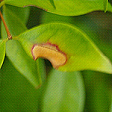 Syzygium species
Syzygium species
Syzygium species are infected by fungal leaf spots but normally control is not required.
Tagetes species are infected by the leaf spot (Septoria tageticola), which starts at the base and moves progressively up through the plant, covering the leaves in grey to black spots.
Trillium species are host to several leaf spots, including (Colletotrichum peckii) (Gloeosporium Trillii) (Heterosporium trillii).
Ulmus species are infected by many fungal leaf spots including (Gnomonia ulmea) and (Cercospora sphaeriaeformis).
Veronica species are infected by the leaf spot (Septoria veronicae). The symptoms include small violet to brown spots appear on the upper surface of the leaf and correspondingly yellowish brown on the underside. The spots converge forming a scorched shot-hole appearance and eventually death of the leaf.
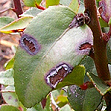 Vaccinium ovatum
Vaccinium ovatum
Vaccinium ovatum is infected by the leaf spot (Rhytisma vaccinii) and (Dothichiza caroliniana).
Vicia species are infected by the leaf spot (Erostrotheca multiformis), which forms greyish spots that enlarge and may defoliate the plant.
Wisteria species are infected by three fungal leaf spots (Phyllostica wisteriae), (Septoria wisteriae) and (Phomatospora wisteriae).
Non-chemical Control
Remove and destroy infected plant material and avoid overhead watering. When planting select infection resistant varieties. Practice crop rotation and add pot ash to the soil to decrease the plants venerability to the disease. Many species of fungus overwinter in fallen leaves, remove and destroy any litter under the plant.
Winter Fusarium Leaf Disease in Turf Grasses can be minimised by aerating the soil, reducing thatch and avoid excessive nitrogen in the soil.
Chemical Control
Protective fungicides such as zineb or copper oxychloride should be sprayed at the first sign of infection and cuttings should be sprayed as they start to grow.
Note
Always read the label for registration details and direction of use prior to application of any chemicals.
DISEASE
NAME
Sclerotinia Rot, Crown Rot
Sclerotinia species
Description
A fungal problem that attacks plant parts causing them to collapse and rot, including flower, leaf and stems.
Symptoms
This fungus attacks all the above ground parts of the plant but commonly infects the stem at the base, where it forms a soft, light brown watery rot that spreads rapidly. Under humid conditions the rotted areas forms white fluffy mycelium on which black sclerotia up to 10mm long develop. These sclerotia also form within the stem in affected areas. When leaves are infected the tissue may brown and dry out, especially during arid conditions. The resulting affect of infection is the death of the plant.
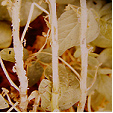
Image by B. Sonsie
Crown Rot (Sclerotium delphinii) causes leaves to turn yellow then become dry, and blossoms to wilt eventually killing the entire plant. It is found on Scilla, Viola and Delphinium species.
Flower Blight (Sclerotinia camelliae) infects flowers either by attacking the top of the petals forming brown specks or at the base of the flower where the petals turn brown then fall with out any sign of rot. The fungus develops on the fallen petals where microconidia are produced under moist conditions and eventually sclerotia appear. This form of the fungus can overwinter either above or below soil level until favourable conditions occur, then the spores are released and dispersed by wind.
Source and Dispersal
Sclerotia are found in the soil or on other infected plants and released spores are dispersed by wind.
Favoured Conditions
Prefers cool moist conditions with temperatures from 10º to 25ºC and is more common from autumn to spring when it is wet.
Affected Plants
A wide range of plants can be infected included French beans, peas, celery, cabbage, cauliflowers, carrot, parsnip, dahlia stocks, primula and many weeds.
Actinotus, Dampiera, Westringa species and Helichrysum bracteatum are infected by the Crown Rot (Sclerotinia rolfsii). Basial rot of the plant with cottony fungal growth and is associated with root congestion. Certain species of orchid may also be attacked.
Allium species are infected by the White rot (Sclerotium cepivorum) which is a major fungal disease of plants.
The bulb rot and are covered in mycelial which develop small black sclerotia (fruiting bodies) and infected plants may fail to produce flowering stem with the leaves become covered in a white mould, turning yellow then dieing off. It is commonly transmitted by infected seedlings and diseased plants should be burnt. Avoid re-planting Allium species in the infected soil where the spores overwinter. Soil may be infected for several years.
Antirrhinum, Aquilegia, Lobularia and Mathiola species are attacked by the Stem Rot (Sclerotinia sclerotiorum ) which infects the stigma travelling downwards through the flower into the stem where water soaked areas appear causing it to collapse. The flowers become pale and the entire plant may collapse. On inspection flat sclerotia may be seen in the stem.
Camellia species may be infected by Flower Blight (Sclerotinia camelliae) which causes blooms to fall and Stem Rot (Sclerotinia sclerotiorum).
Hyacinthus species can be infected by the fungus Black Slime (Sclerotinia bulborum) that causes the leaves to turn yellow then fall and bulbs to disintegrate.
Iris species are infected by the fungus Rhizome Rot (Botryotinia convoluta) that infects the rhizomes and forms black sclerotia, and is normally found on dieing plants during spring.
Turf Grass in warm climates is susceptible to Rolf's Disease (Sclerotinia rolfsii). The fungus infects the turf causing isolated dead patches up to 450mm across from spring to summer. As it progresses the dead patches increase in size and the white cotton-like mycelium can be seen in the underlying soil. It is not regarded as a major problem, with minor attacks on Cynodon dactylon (Couch) and Zoysia species.
Non-chemical Control
Initially remove and destroy any infected plants, when replanting, avoid using susceptible crops for 3 years. Space the plants to reduce the humidity and airflow and cultivate the soil to increase the drainage. Remove weed growth and leaf or flower litter from around the base of the plants to reduce the development of spores
Turf Grass culture such as aerating soil and maintaining a neutral pH helps prevent infection of Rolf's Disease.
Chemical Control
No suitable fungicides available, though drenching or spraying the soil with the fungicide dichloran helps control it.
DISEASE
NAME
Root Knot & Other Nematodes
Meloidogyne & other species
Description
Root Knot Nematode or eelworms are transparent thin nematodes that are an organism up to 0.5mm long and attacks the roots by injecting saliva that stimulates the surrounding cells to form galls. The adult male lives in the soil and the female are found in the roots, laying up to 2,000 eggs in a mass in the soil adjoining the roots.
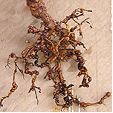
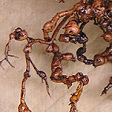
Symptoms
Above ground the plant infected by Root Knot Nematode develops slowly and is stunted. During hot weather the plant wilts easily as it is unable to keep up with the transpiration rate and under extreme conditions the plant dies. The young nematodes attack the roots forcing there way up the root tips forming galls. On inspection the galls are found centrally located along the roots and are up to 20mm across. The galls slow the rate of nutrients and water passing through the plant and as the galls break down they allow opportunity for other diseases to enter the plant.
The roots are severely damaged if the galls are physically removed.
Other species of nematode have simular symptoms and are individually discussed below.
Source and Dispersal
The nematodes are found in soil or in infested plants and are dispersed by water, soil movement and attached to tools or shoes.
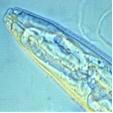 Nema Head
Nema Head
Favoured Conditions
It prefers sandy soil types and a warm moist weather conditions.
Life Cycle
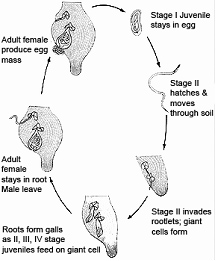
Affected Plants
A wide range of plants are attacked by the Root Knot Nematode including tomatoes, potatoes, carrots, tobacco, hibiscus, gardenia and roses. Some species of nematodes are plant specific such as (Meliodogyne incognita) which attacks Hemerocallis, Celosia and Viola species, forming small wart-like swelling on the roots.
Alternanthera, Begonia, Dianthus, Psidium, Thunbergia and Weigela species are attacked by the Root Nematode (Meloidogyne incognita). This forms small swellings on the roots causing the top growth to be stunted and not responding to improved culture. In cool climates it is found on plants in glasshouses.
Buxus species are attacked by the Meadow Nematode (Pratylenchus species) that turn the leaves a bronze colour and cause stunting of the plant. These microscopic nematodes enters through the roots and eventually result in the death of the plant.
Lagunaria patersonii is attacked by a simular nematode, the Root Burrowing Nematode (Radopholus similis) that feeds by burrowing in the outer root tissue.
Lavandula species that are grown in the northern United States are susceptible to the Peanut Root Knot Nematode (Melioidogyne hapla). Berberis species are also susceptible.
Tulipa species are attacked by Bulb and Stem Nematode (Ditylenchus dipsaci) which forms brownish streaks along the stem that may blister and may cause wilting. The flowers petals become distorted and the general vigour of the plant poor.
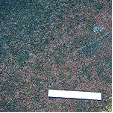
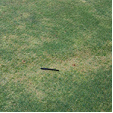 Nematodes damage
Nematodes damage
Turf Grass are susceptible to several Parasitic Nematodes including (Helicotylenchus species), (Xiphenema Species), (Hemicycliophora species) and (Ibipora lolii). All turf grasses are susceptible and the nematodes are active from spring to autumn requiring a soil temperature 15 ºc. The leaves become chlorotic and have a weak appearance as a result of the damaged roots. Generally it is only a major problem when the nematode numbers are very high, otherwise control is not warranted.
Cultural Control
Crop rotation in infected soils, avoid using plants from the Brassicaceae family for up to four years and plant species that are tolerant of nematodes, this will reduce numbers. Beds may be laid fallow for several seasons to deter nematodes, but numbers build up quickly once susceptible plants return.
Affected plants such as roses may have the bare roots dipped in hot water 45ºC for 15 minutes during the dormant period and contaminated growing media can be heat treated at 60ºC for 30 minutes before being used.
Any infested plants should be removed and destroyed or deposed off site.
Improve the soil structure and avoid acidity by the addition of lime or dolomite. Garden beds may also be pre planted with marigolds or mustard to deter nematodes, but should be removed or thoroughly composted prior to planting as they can push nematodes towards the crop. Green manure crops may be grown prior to planting and infested soil may require up to three seasons of manure crops to bring nematodes under control.
Biological Control
The encouragement of earthworms reduces nematode numbers as they accidentally eat them in there normal course of growth.
Chemical Control
The soil can be treated with a nematicide such as fenamiphos in a domestic situation. Commercial growers may fumigate the soil prior to planting with the appropriate chemicals.
Note
Always read the label for registration details and direction of use prior to application of any chemicals.
DISEASE
NAME
Dry Patch in Turf
Fungal Dry Patch
Description
It is commonly seen as a non-pathogenic fungus that repels water in sandy soils.
Symptoms
Dead patches of lawn appear as the underling soil becomes dry and repels water. Only the dead grass is attacked by the fungus that produces a substance which coats the soil particles, making them water replant. This is known as hydrophobic (water-hating).
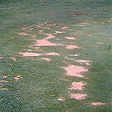
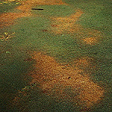
Source and Dispersal
The fungus is found in most soils and is a small layer of fungi mycelium which blocks the micro pores of the soil.
Favoured Conditions
It is more prevalent in sandy soil; types.
Affected Plants
Dry Patch affects all turf grasses.
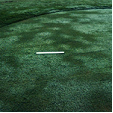 Early stage on a Green
Early stage on a Green 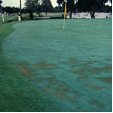
Non-chemical Control
Preventive measures such as aerating the soil with a garden fork and applying a wetting agent should be carried out before the warm weather. Care should be taken when using wetting agents to improve soil absorption as it may have a detrimental effect on the foliage. Coring and back filling with sandy loam in Turf Grasses reduces incidences of Dry Patch.
Chemical Control
There is no satisfactory chemical control.
Average Lowest Temperature : -1º C 30º F
USDA : 9, 10, 11, 12
This USDA (United States Department of Agriculture) hardiness zone chart can be used to indicate a plant’s ability to withstand average minimum temperatures. However, other factors such as soil type, pH, and moisture, drainage, humidity and exposure to sun and wind will also have a direct effect on your plant’s survival. Use this chart only as a guide, always keep the other factors in mind when deciding where, when and what to plant.
A plant's individual USDA zone can be found in the Plant Overview.
Region of origin
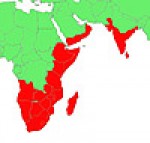
Africa to India
Climate Description
Warm to Sub-tropical
This overlaping zone has ample rain with high summer temeperatures and high humidity. Winters are mild. Pockets of sub-tropical climates exist within coastal warm temperate zones.
Frosts and droughts rarely occur along the coast.
Plant growth
Tropical and warm temperate native and exotic plants grow well.
| Dictionary | Growth Habit |
| Leaf Type | Botanic Flower Description |
| Leaf Shape | Flower Inflorescence |
| Leaf Arrangement | Fruit Type |
| Leaf Margin | Bark Type |
| Leaf Apex And Bases | Flower Description |